1lumen selects and reviews products personally. We may earn affiliate commissions through our links, which help support our testing.
Acebeam Pokelit 2AA review
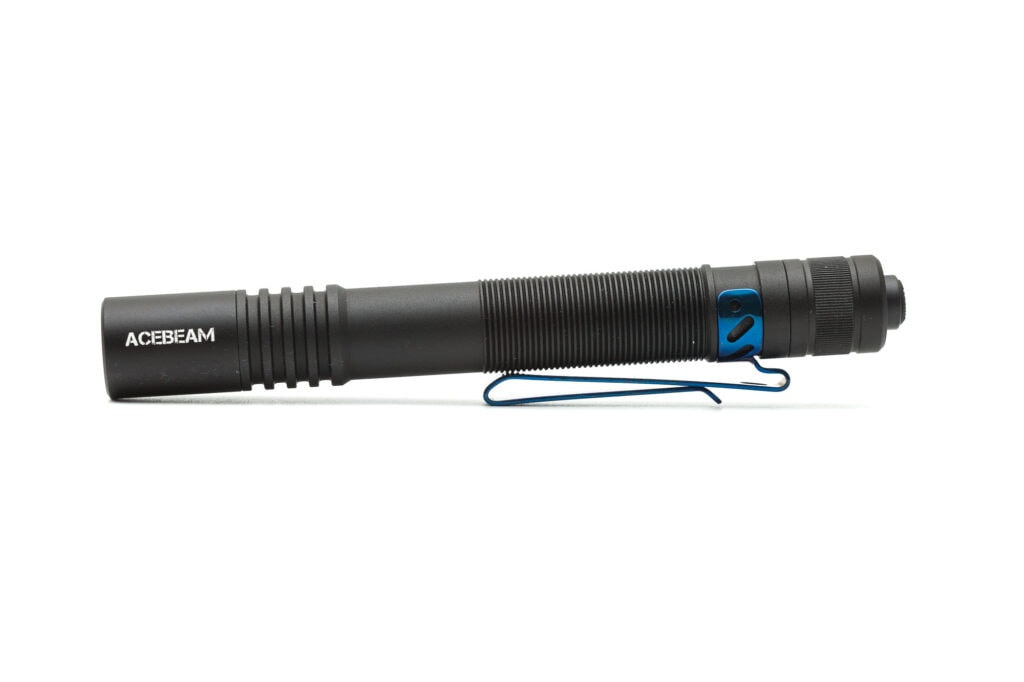
Acebeam Pokelit 2AA specifications
| Brand/model | Acebeam Pokelit 2AA |
|---|---|
| Flashlight category | EDC / breast pocket light / inspection light |
| LED | Nichia 519A , 5000K, high CRI |
| Max. output | 600 lumens |
| Max. beam distance | 101 meters |
| Max. beam intensity | 2,550 cd |
| Battery config. | 2*AA / 1*14100 |
| Onboard charging | N/A (battery has USB-C charging) |
| Modes | 2 |
| Blinkies | N/A |
| Waterproof | IP68 |
| Review date | November 2022 |
Introduction:
Acebeam has been around for several years, and keep adding new and interesting flashlights. They still only focus on lighting products (flashlights, headlamps etc). The one I am reviewing now is their latest (and probably only) 2AA flashlight, the Pokelit 2AA.
As the name implies, it’s a penlight flashlight running of 2 readily available AA batteries, both primaries as rechargeable. But on top of that, Acebeam built a proprietary 14100 lithium-ion rechargeable battery for max performance. And yes, there is a huge difference between the lithium battery and 2 AA batteries.
Since I have been working on the Penlight buyers guide, I wanted to see if the Pokelit would actually fit that category as well. Let’s find out.
Package quality.
For the price, you get a pretty decent box with the following inside;
- The flashlight: Acebeam Pokelit 2AA
- Pocket clip (pre-attached)
- 14100 lithium-ion battery
- USB-C charging cable for the 14100 battery
- Spare O-ring
- Manual
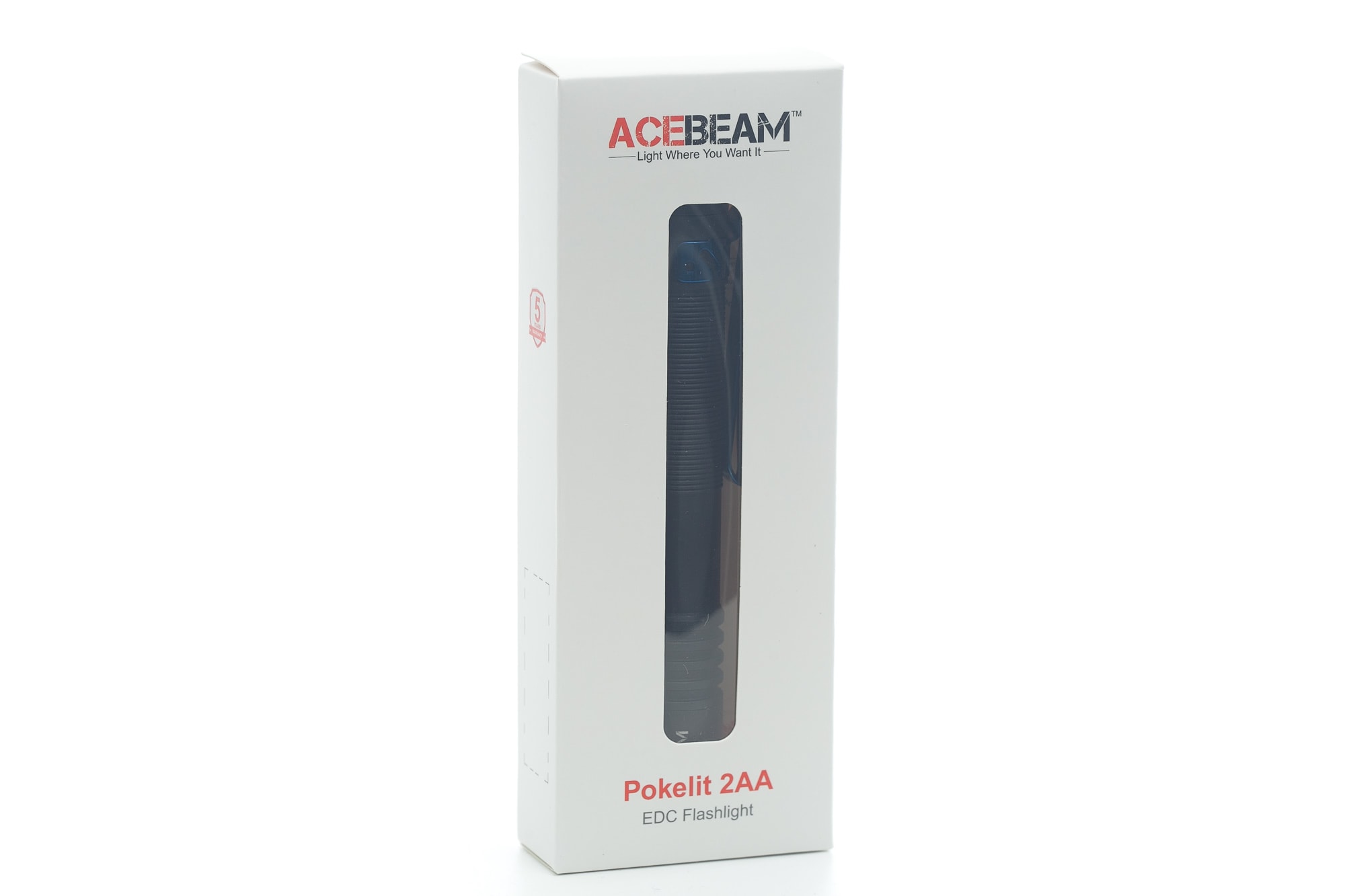
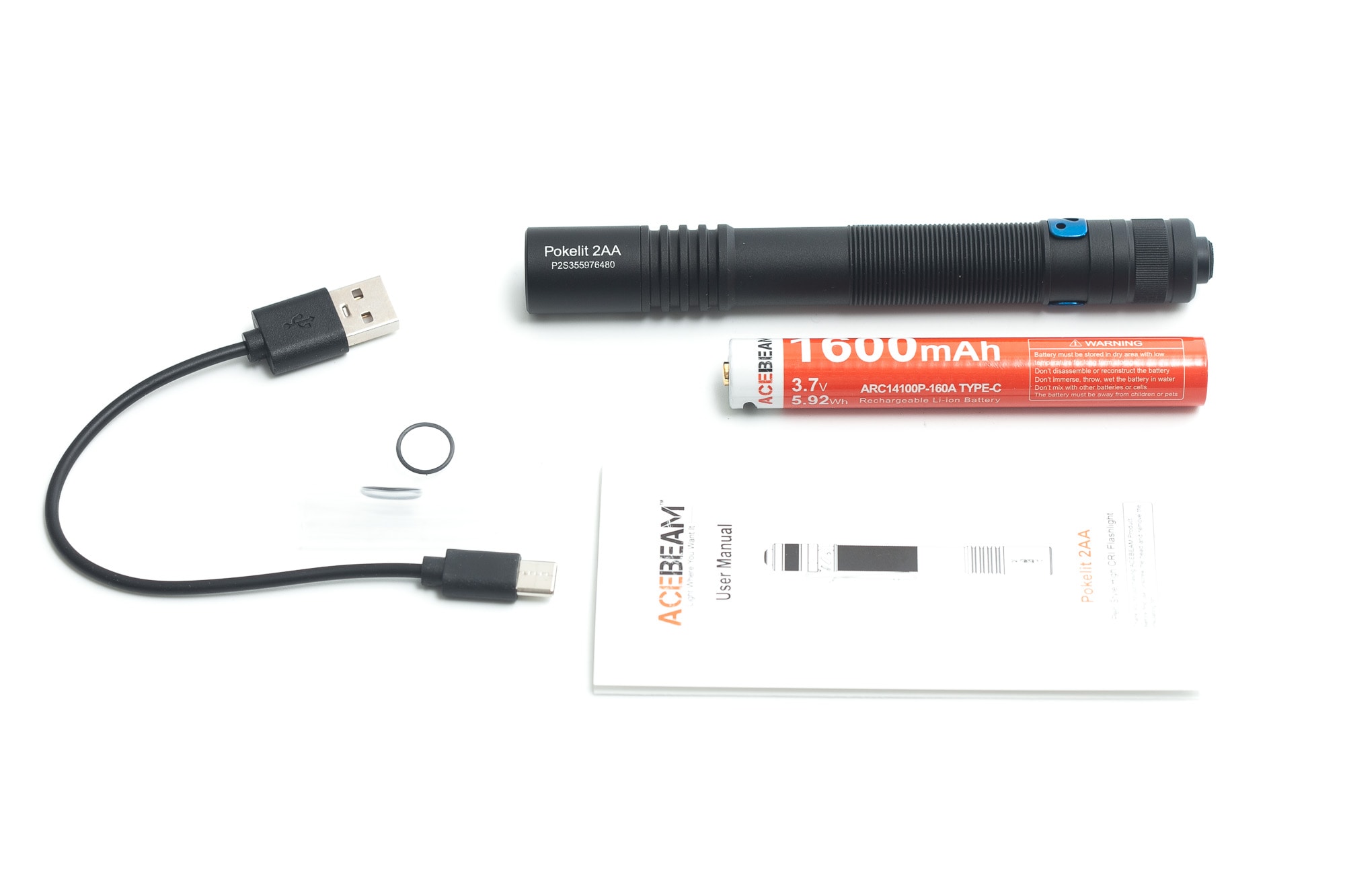
Flashlight in use
From all the penlight flashlights out there, I think the Pokelit 2AA is on the border. It’s quite big, compared to 2AAA flashlights, but still smaller than other 2AA flashlights like the Fenix LD22 v2 Nick had reviewed.
Just like all penlights I currently own, the switch is protruding, so you can’t make it tail stand. The switch feels like you’re pushing a piston down a tube, before you reach the switch. Not sure how else to describe it.
It is a forward clicky switch, so the light turns on before you hear the switch, but it doesn’t feel the same as a normal forward clicky either. Normally, you’ll feel some kind of resistance before the actual click. But with this one, there isn’t, and clicks before you know you’re there.
This could be unpleasant when using AA batteries. Why? Because the output is so low, you don’t really know that you activated the light. (More info will follow in the performance section)
You can use the light with an overhand and underhand grip. And since it has only 1 switch, you either have to use 2 hands for activation and mode switching or re-position your hand, so you can put your thumb onto the switch.
Acebeam included (and pre-attached) a 2-way pocket clip for deep-pocket carry as well as giving you the possibility to attach it to your baseball cap. It feels a little uncomfortable that way, but it works. The same pocket clips works like a anti-roll feature on a slightly included surface.
There is no lanyard included in the package, but you can attach one to the pocket clip if you would like to.
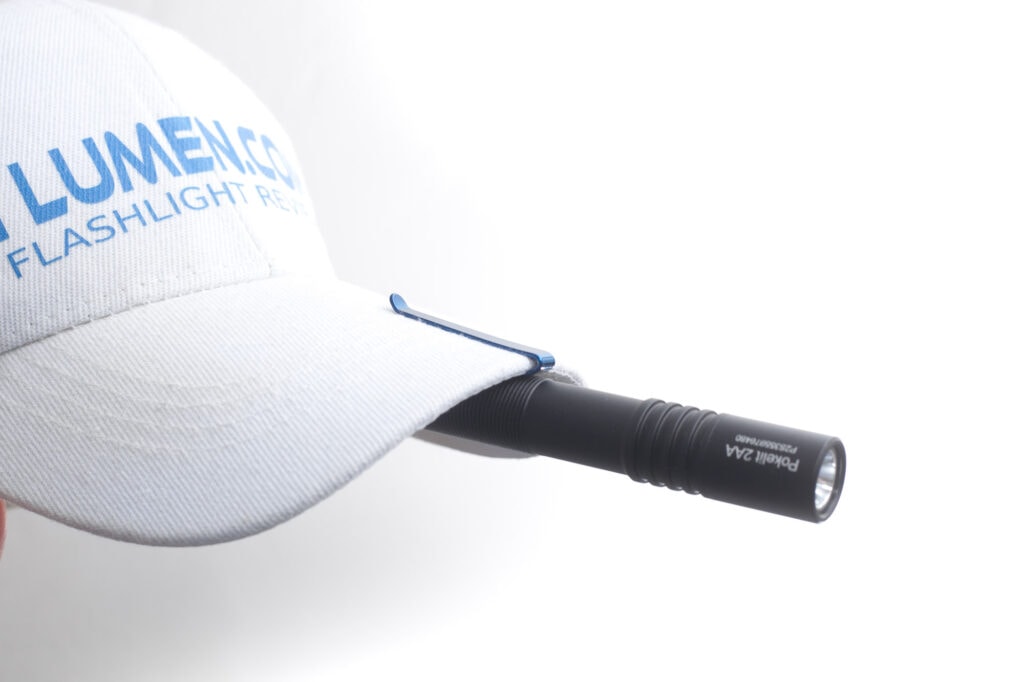
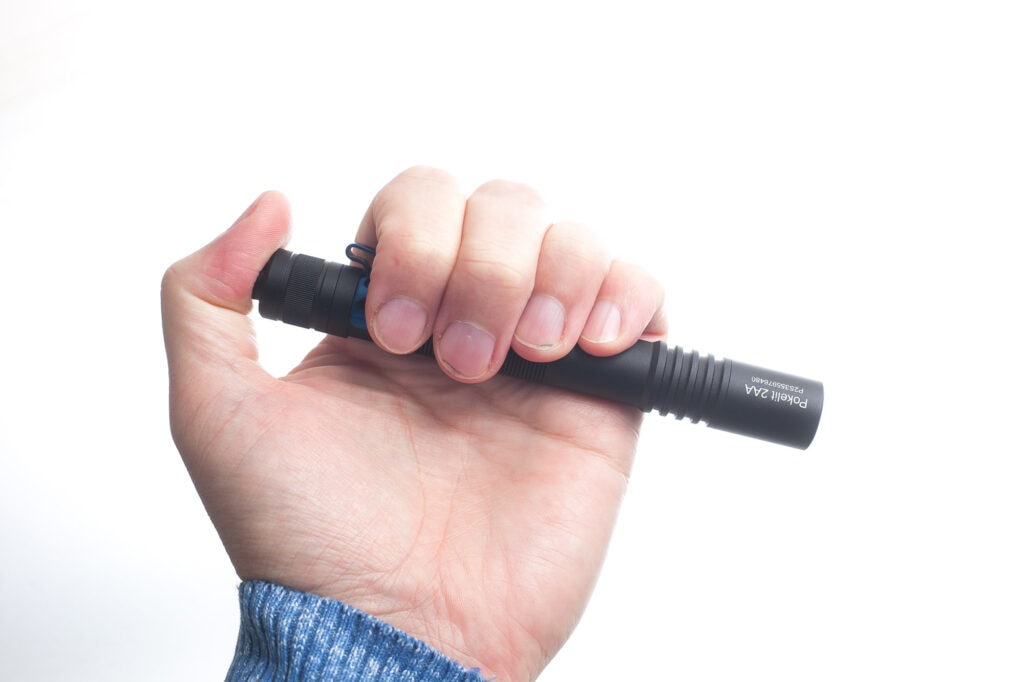

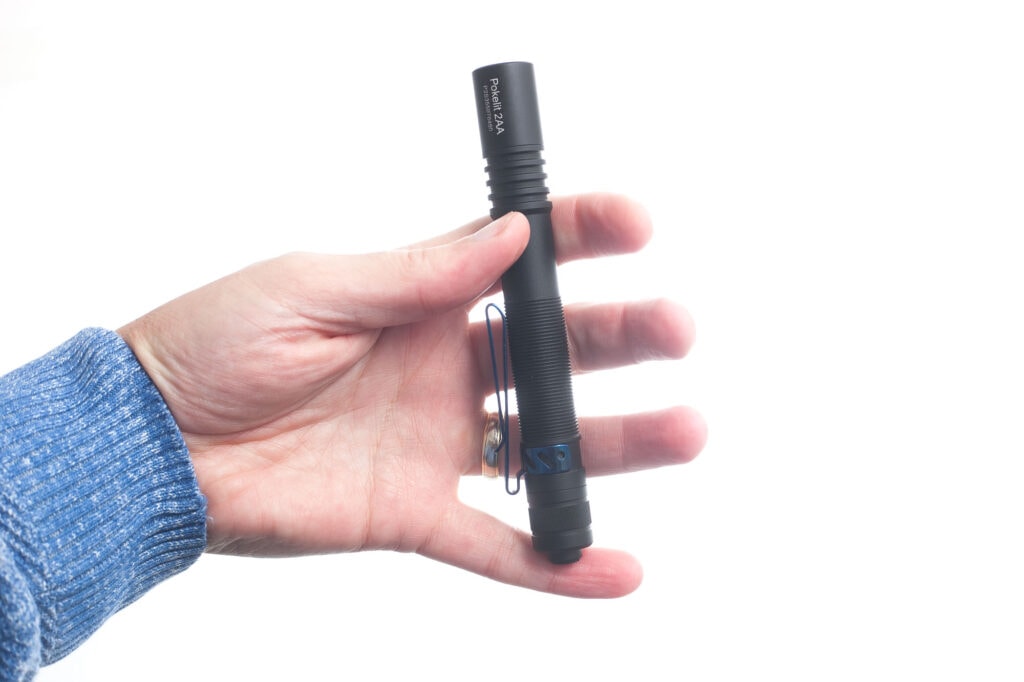
Build Quality, and Warranty
Acebeam makes really nice and top-notch flashlights. And I can’t really complain about the Acebeam Pokelit 2AA here either.
The only part that is removable, is the head. That’s also the place where you insert the batteries/battery.
The threads are bare, so even if the head is not fully tightened, you can still turn the light on/off, and change modes. And since it’s using a mechanical switch, you don’t need to worry about the parasitic drain, as you can’t mechanically unlock it, by unscrewing the head. That was a long sentence.
Besides black, there is also a green Pokelit version. Acebeam also introduced a pink one, specifically for NBCF National Breast Cancer Foundation, since Acebeam sponsors them. But they don’t specifically mention whether any profit from the pink P2AA sales goes to that organization, though.
The warranty according to their website:
Warranty terms:
1. If the customer experiences any problems caused by manufacturing defects in normal use with an Acebeam product within 15 days of purchase, the dealer will replace that product.
2. If an Acebeam flashlight fails during normal use and any problem covered under warranty occurs within a period of 5 YEARS (60 months) of purchase, the dealer is responsible for warranty service.
3. Acebeam flashlights enjoy a limited lifetime warranty – after 60 months the dealer will attempt to repair the flashlight for the cost of spare parts and shipping (i.e. no charge for labour).
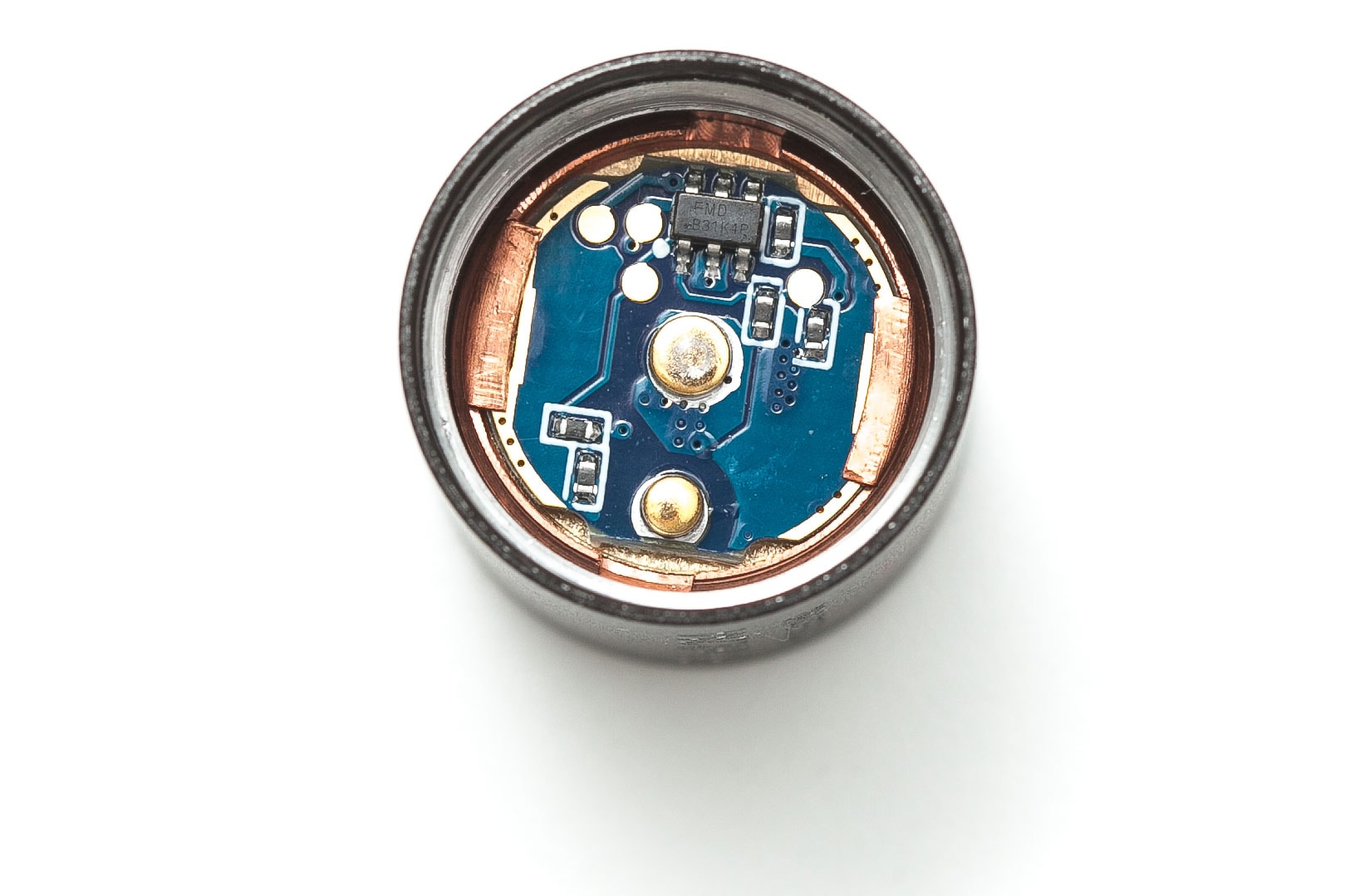
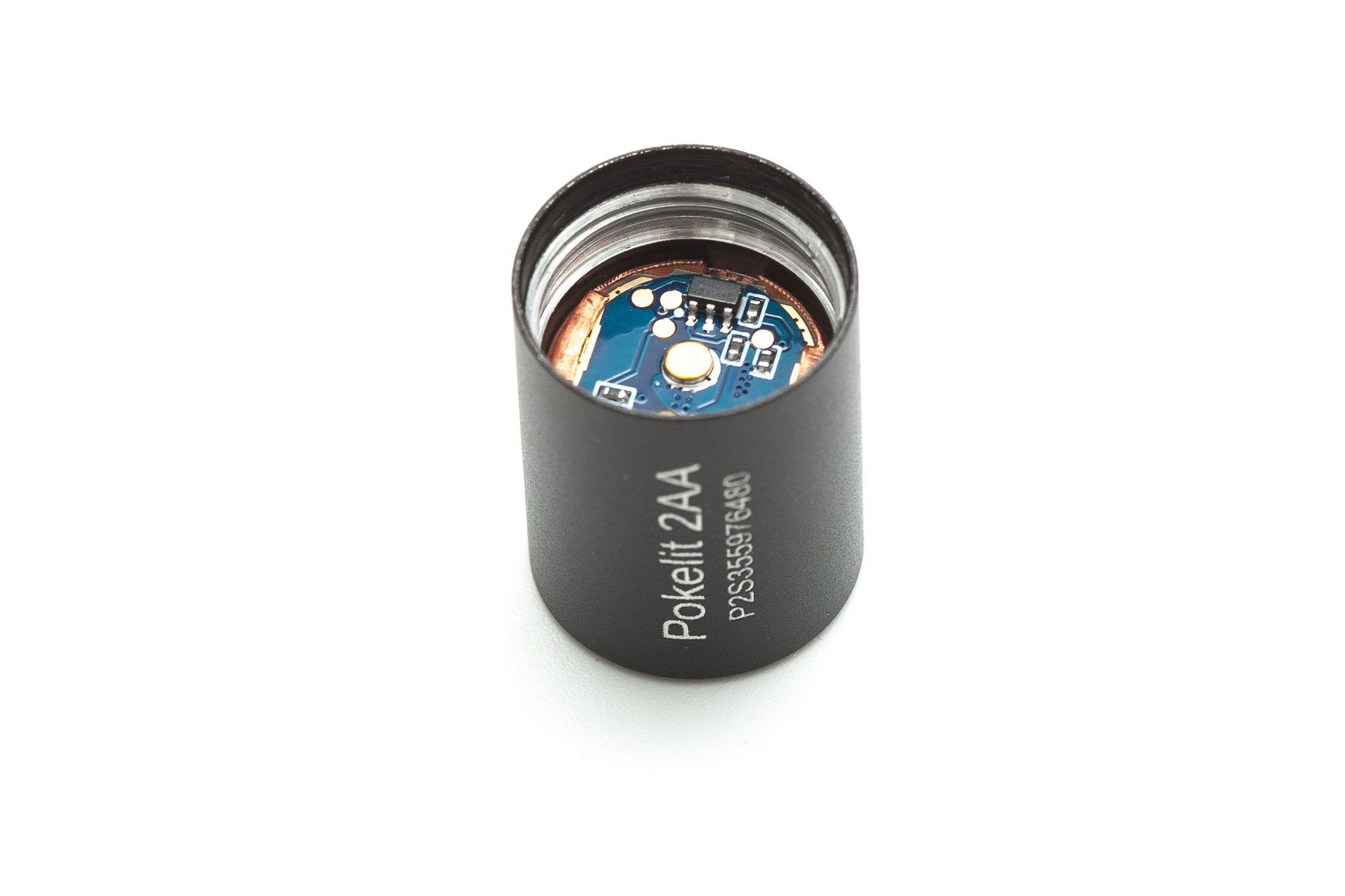
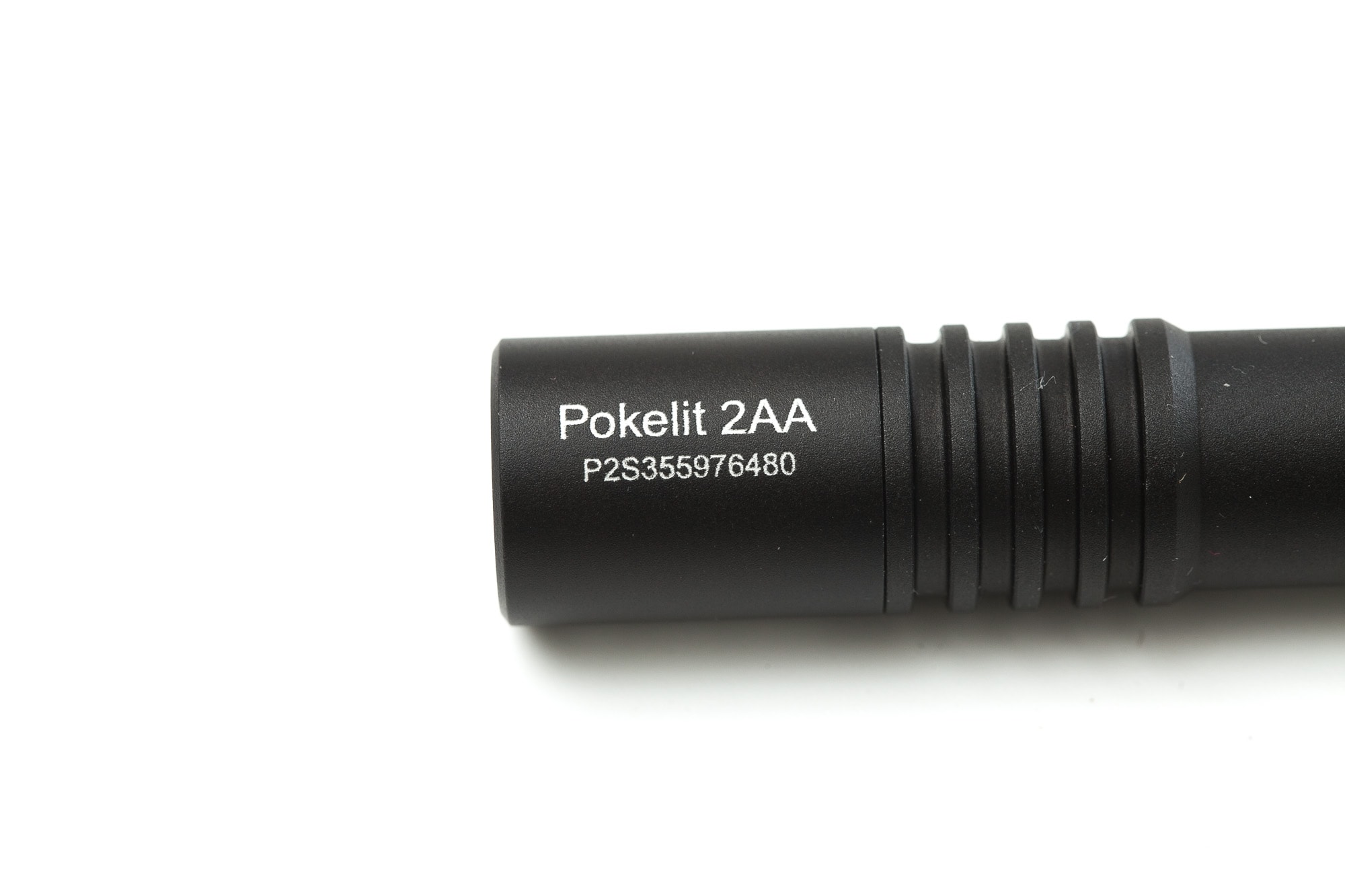
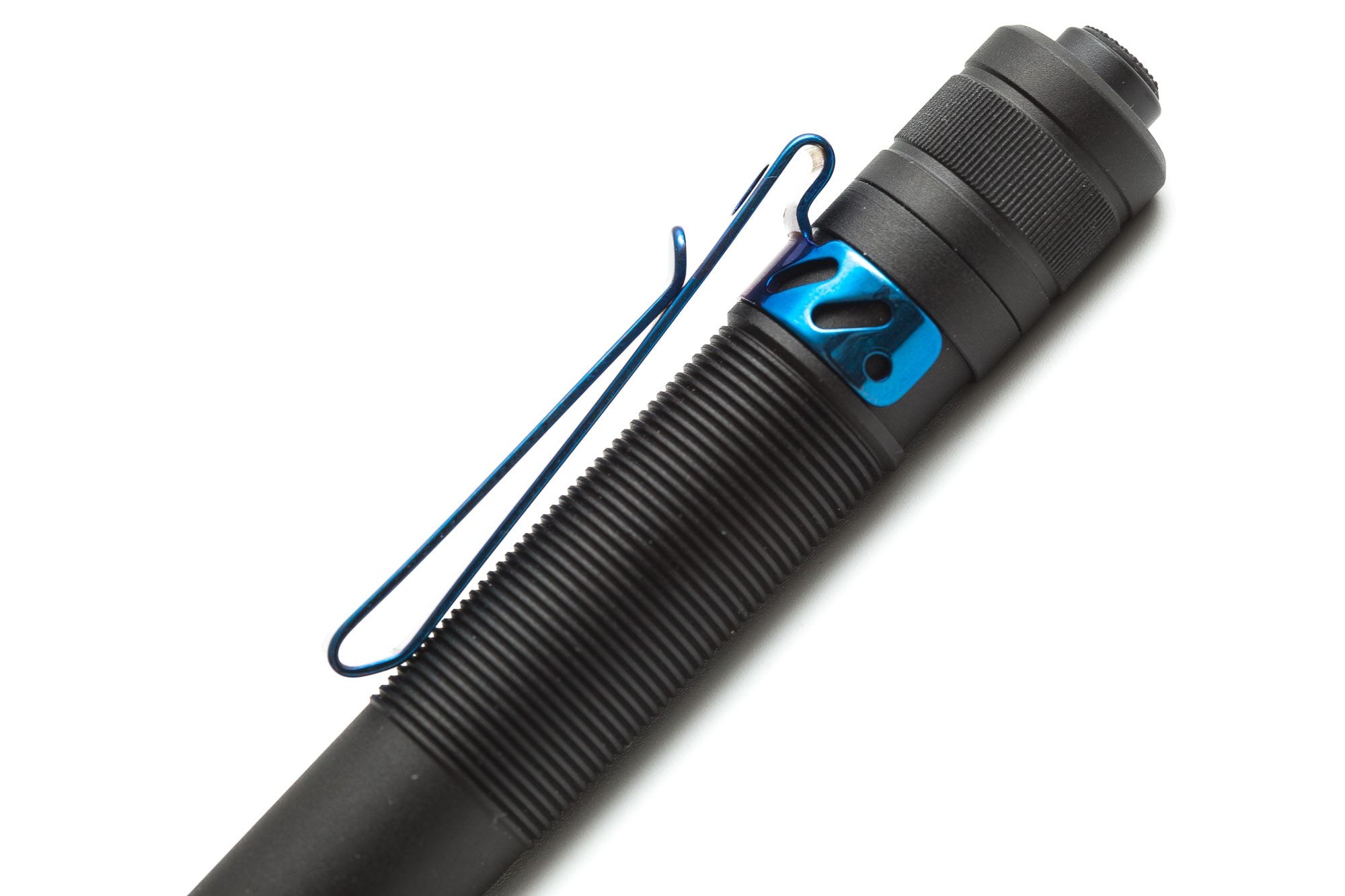
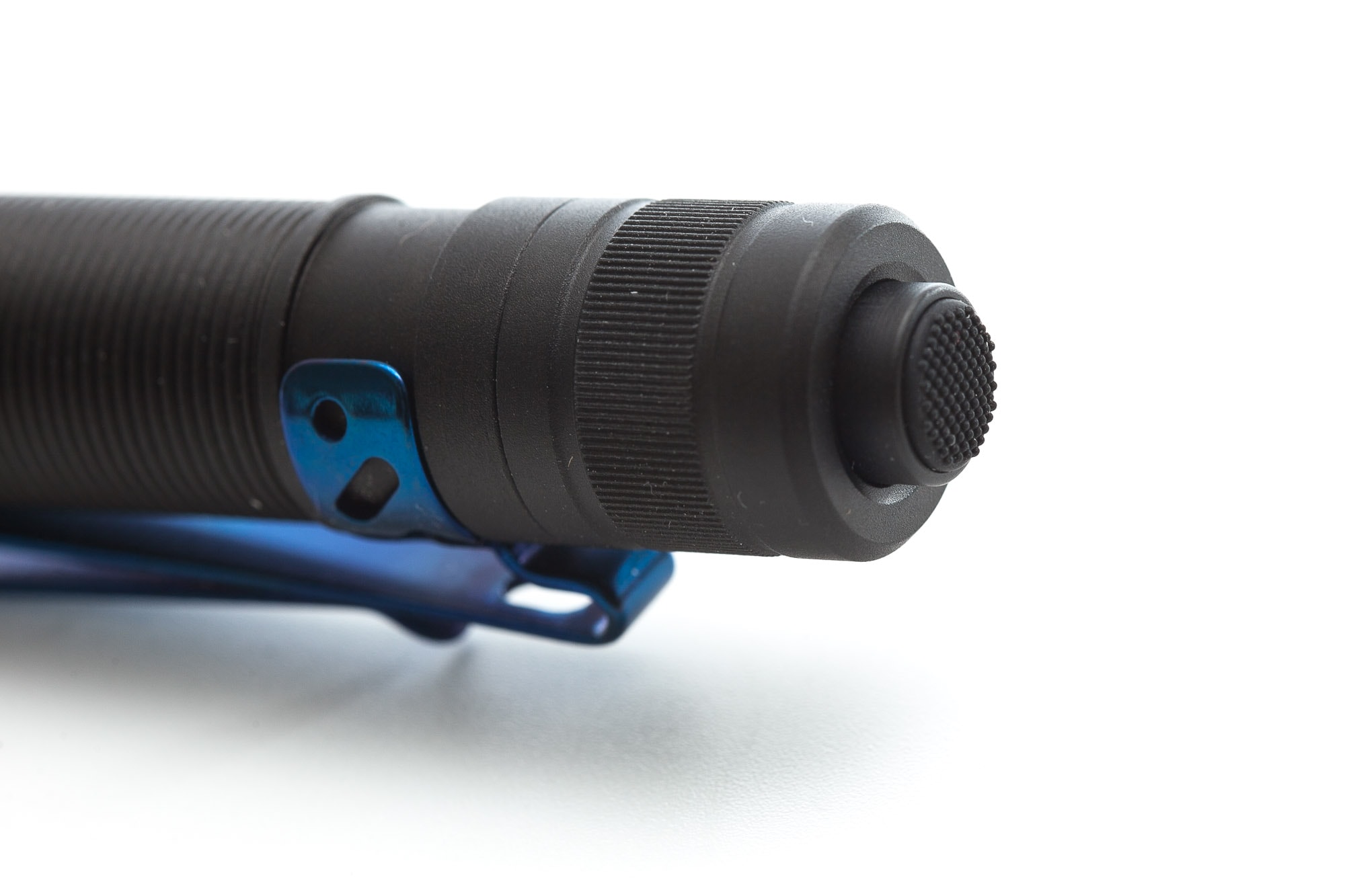
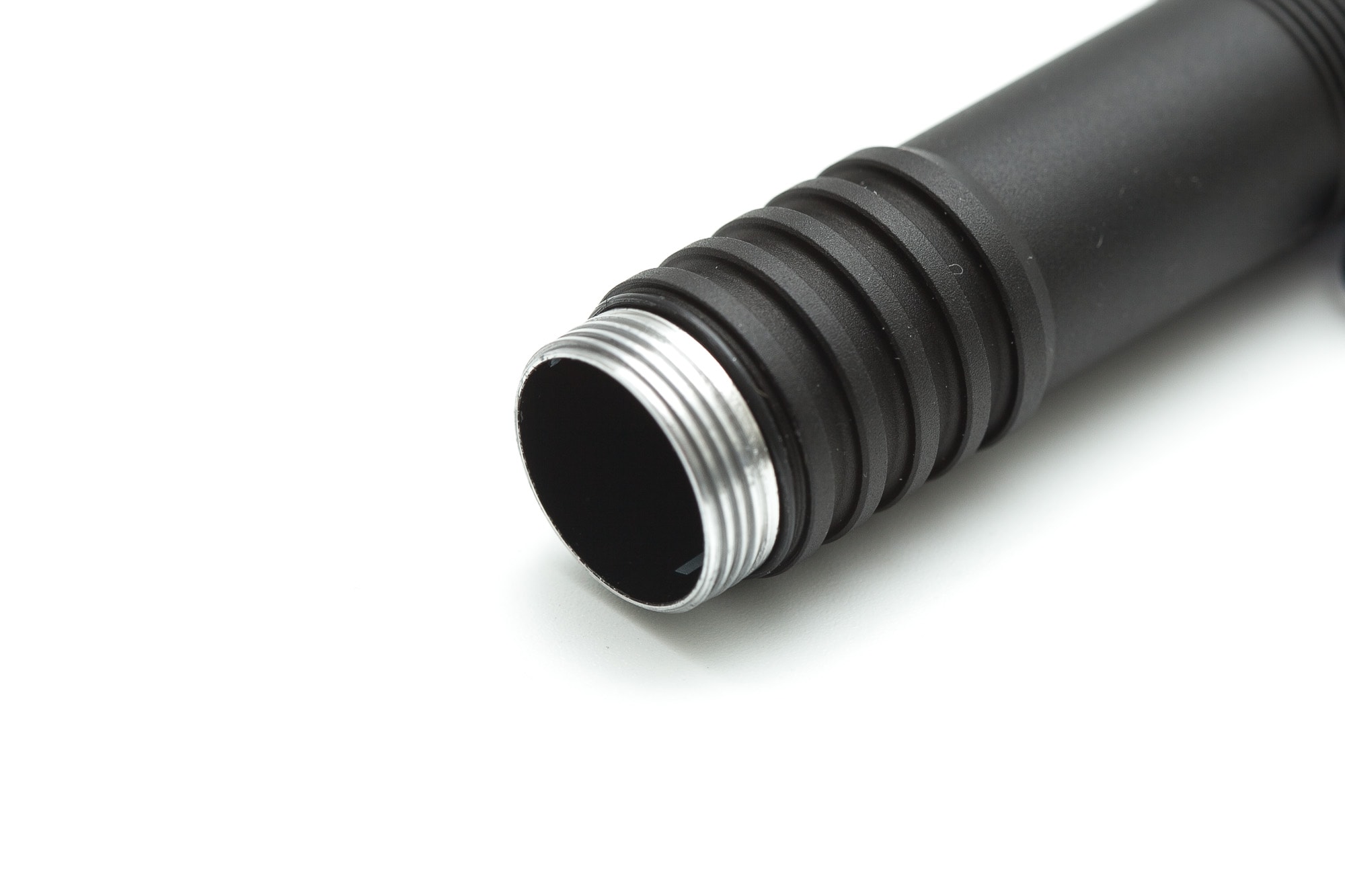
LED, Lens, Bezel, Beam, and Reflector
Acebeam knows that people in the flashlight community like to know what particular LED has been used. And they proudly share that information on their website, as well as on the packaging and in the manual. At least, with the Pokelit 2AA, since it’s using the very popular Nichia 519A, 5000K. Why is it so popular? Well, it’s Nichia quality, it has high CRI, and available in cooler temperatures than just NW or WW. About 1 decade ago, the Nichia 219B were the cream of the crop, but weren’t available above about 4500K. The new 519A is available in 5000K as well as 5700K.
5000K is the color temperature of the beam, and is right in the sweet spot if you asked me. It’s not as yellow as 4000K, and not as cold as 7000K. When you shine a 5000K beam on a white object, the white should be pretty white.. If you shine a 4000K beam on a white object, the white is actually more yellow. My preferred beam temperature is somewhere between 4500-6000K, a bit colder.
As far as I could tell, there is no other LED option. You either get 5000K or 5000K.
During some of my other tests, I noticed that the Nichia 519A with 4500K actually measured closer to 4000K than 4500K, and that the 5000K pretty much was spot on. I’m happy to tell that the 5000K is again spot on, at 5000K.
How I could tell? By using the Opple Light Master III (Pro).
It’s a cheap little device that measures the light temperature (CCT) and CRI Ra (basic, average CRI).
And this is what it measured in High mode:
- CCT: 5049K
- CRI Ra 98.4
Low mode:
- CCT: 4921K
- CIR Ra 99.7
Please keep in mind that this device is not a high-end spectrometer. It gives you a good estimation on how good/bad the light is. And in that regard, it works pretty well.
The beam is definitely neutral/cool white, with a very clear and clean round hotspot. The edge of the hotspot is pretty profound, so you can see a clear difference between the hotspot and the spill. The hotspot is very big but evenly lit. I like that a lot.
One reason is because of the shallow, smooth reflector.
It lacks a normal bezel because the bezel and head are one piece.
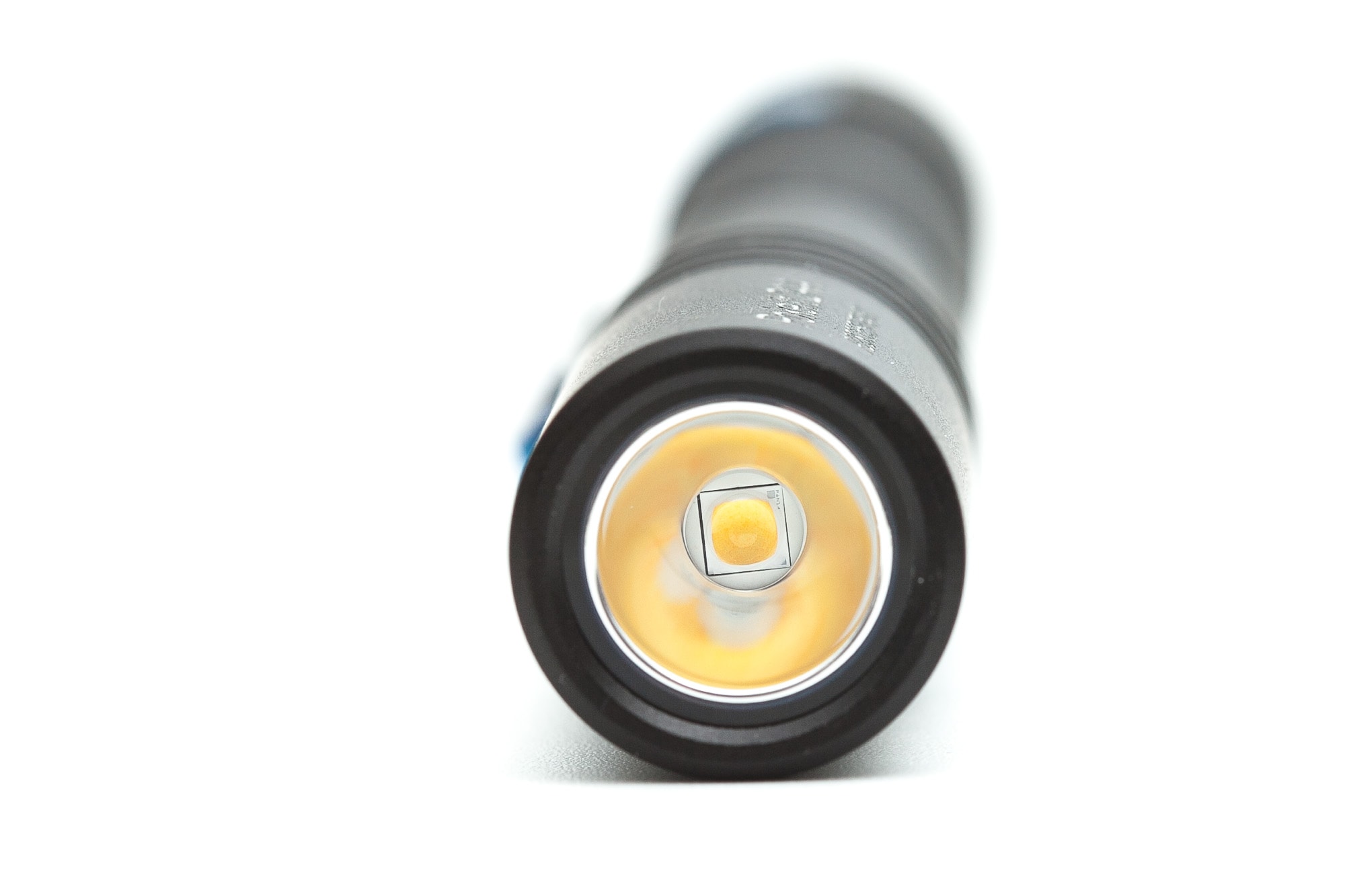
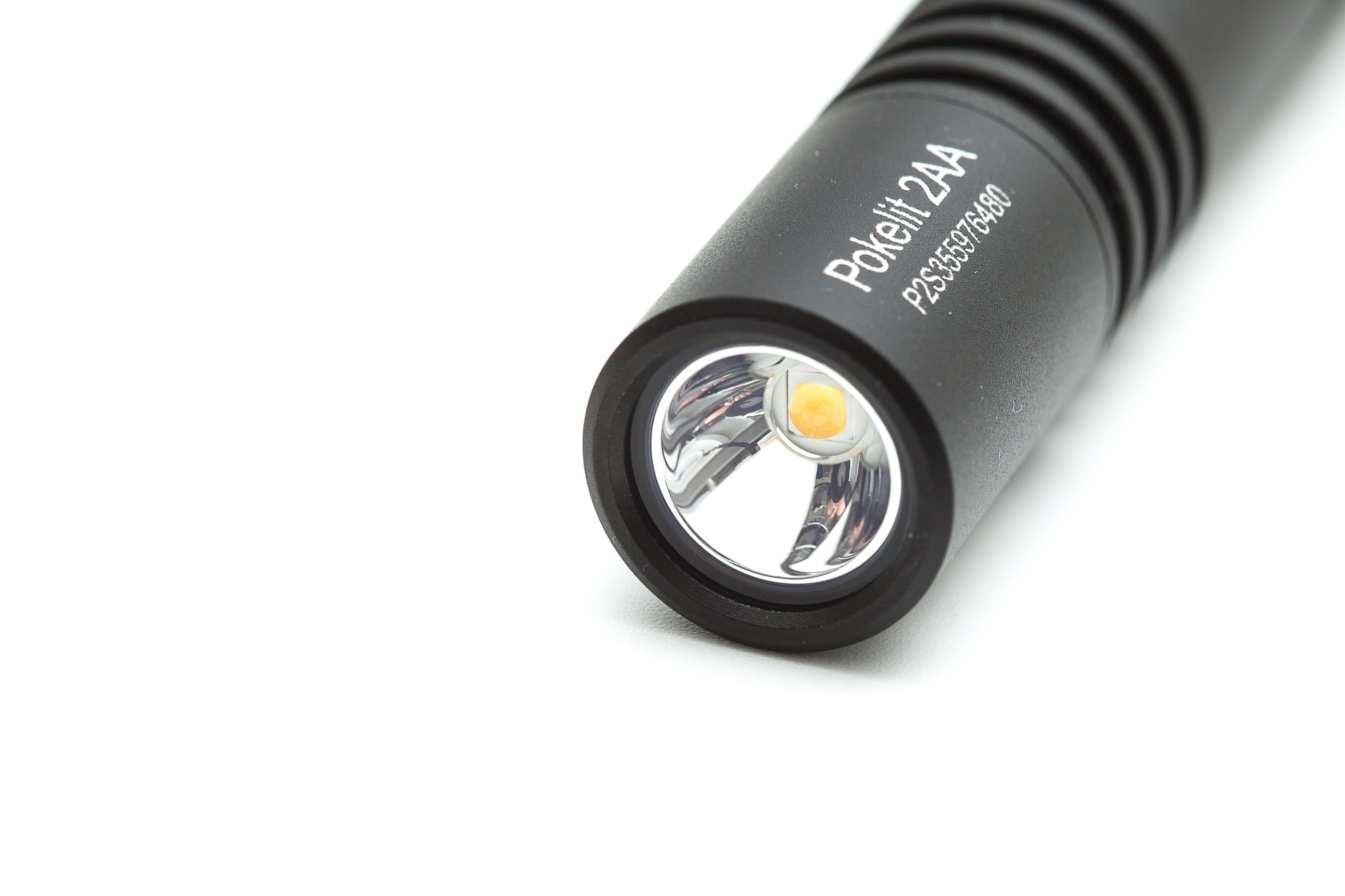
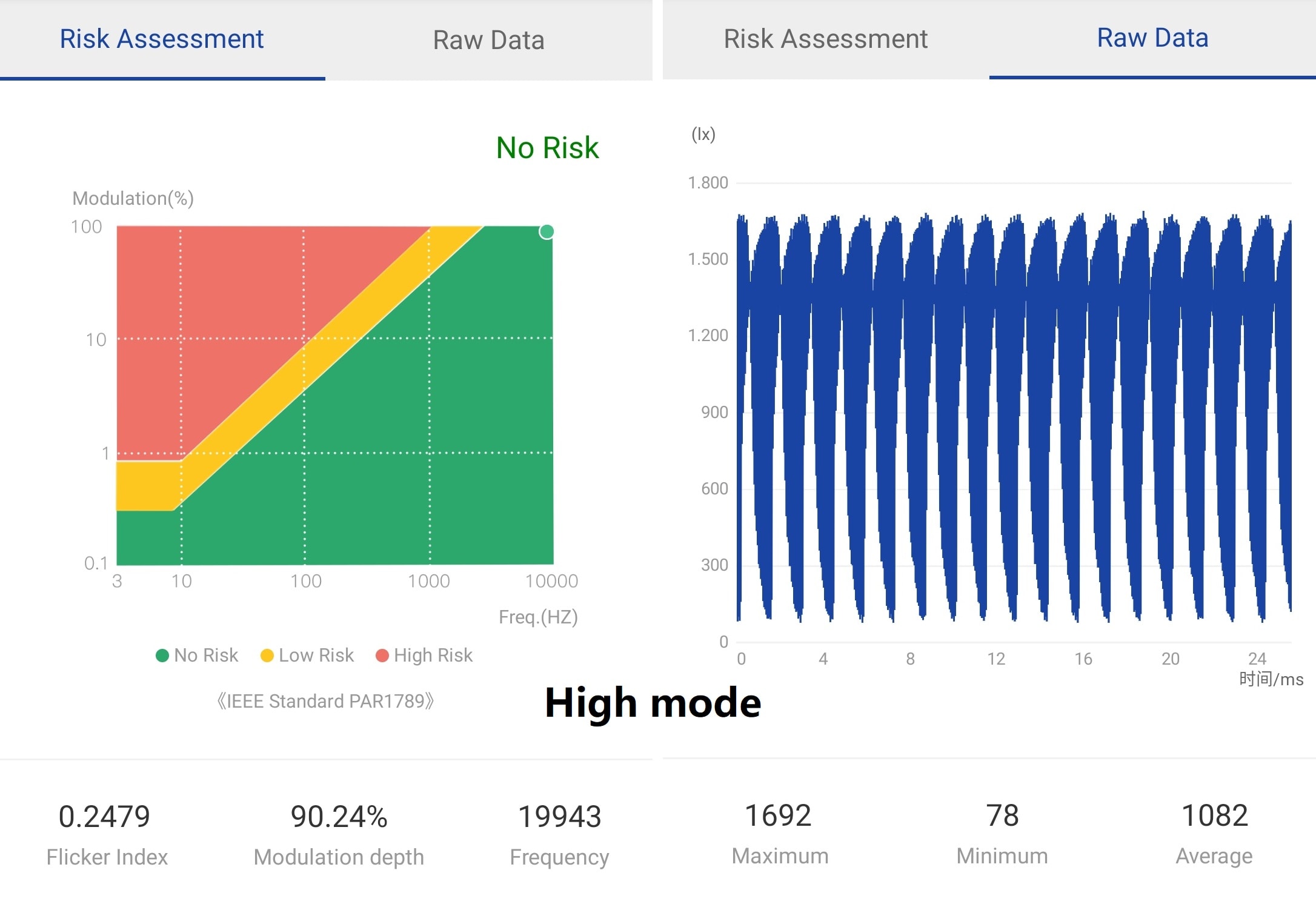
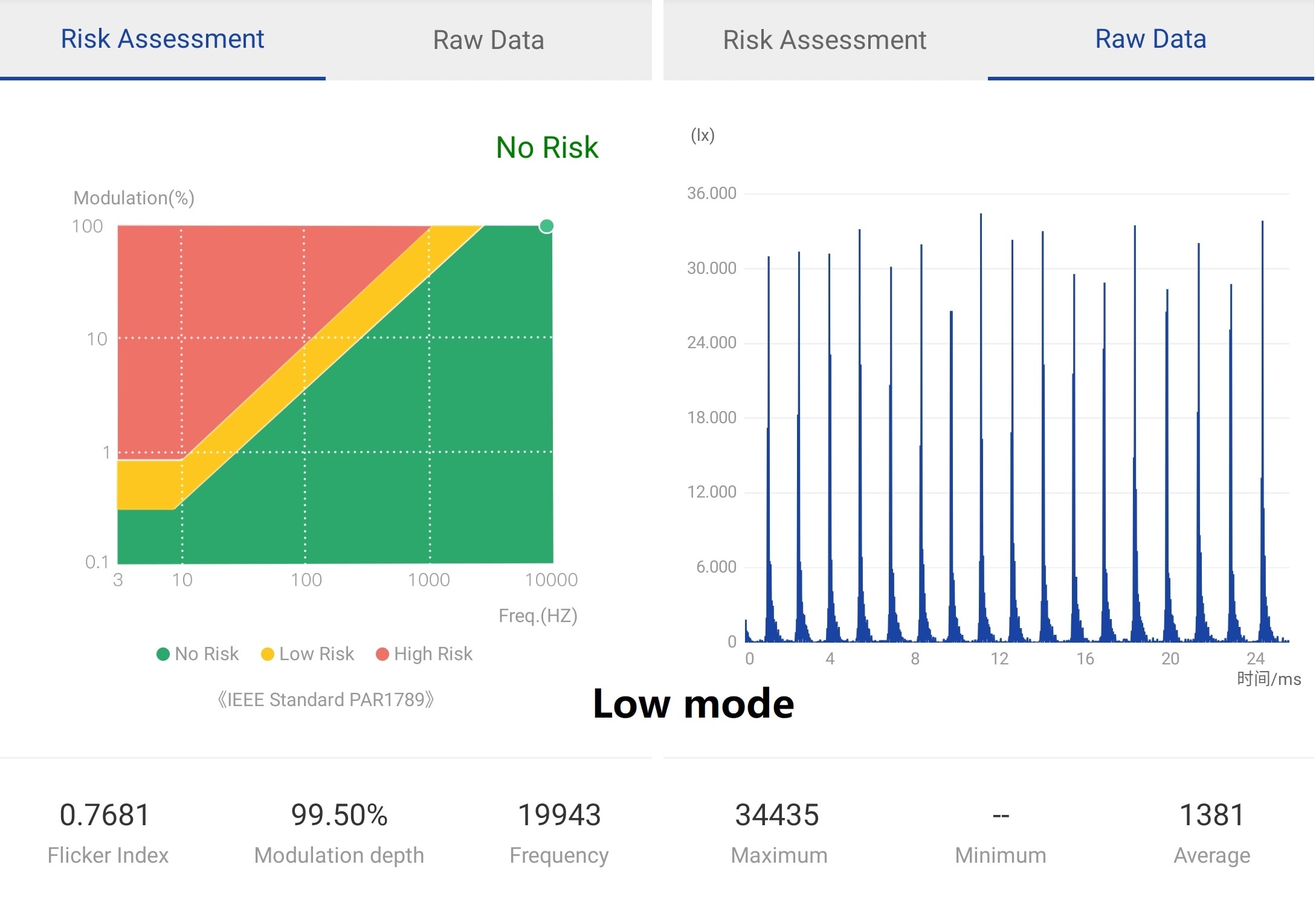
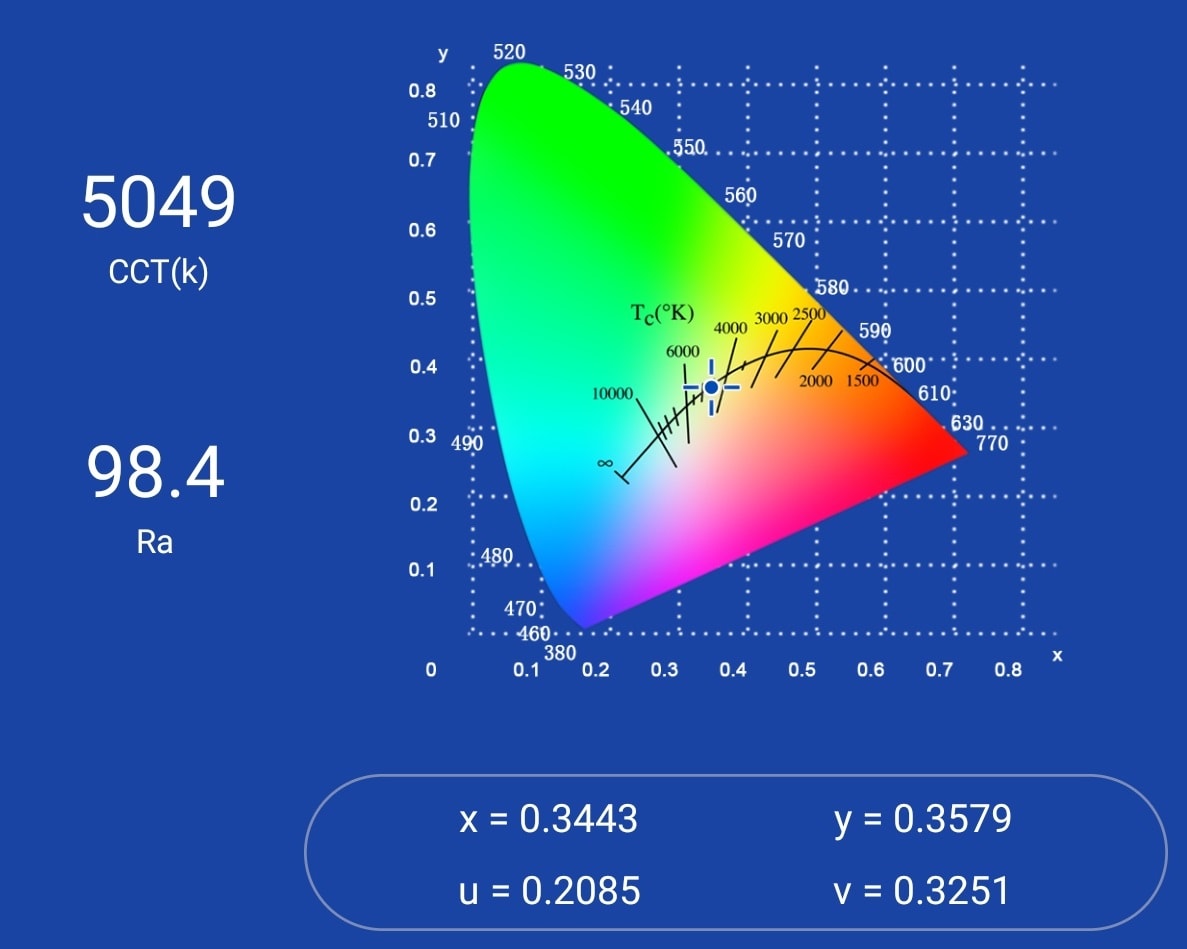
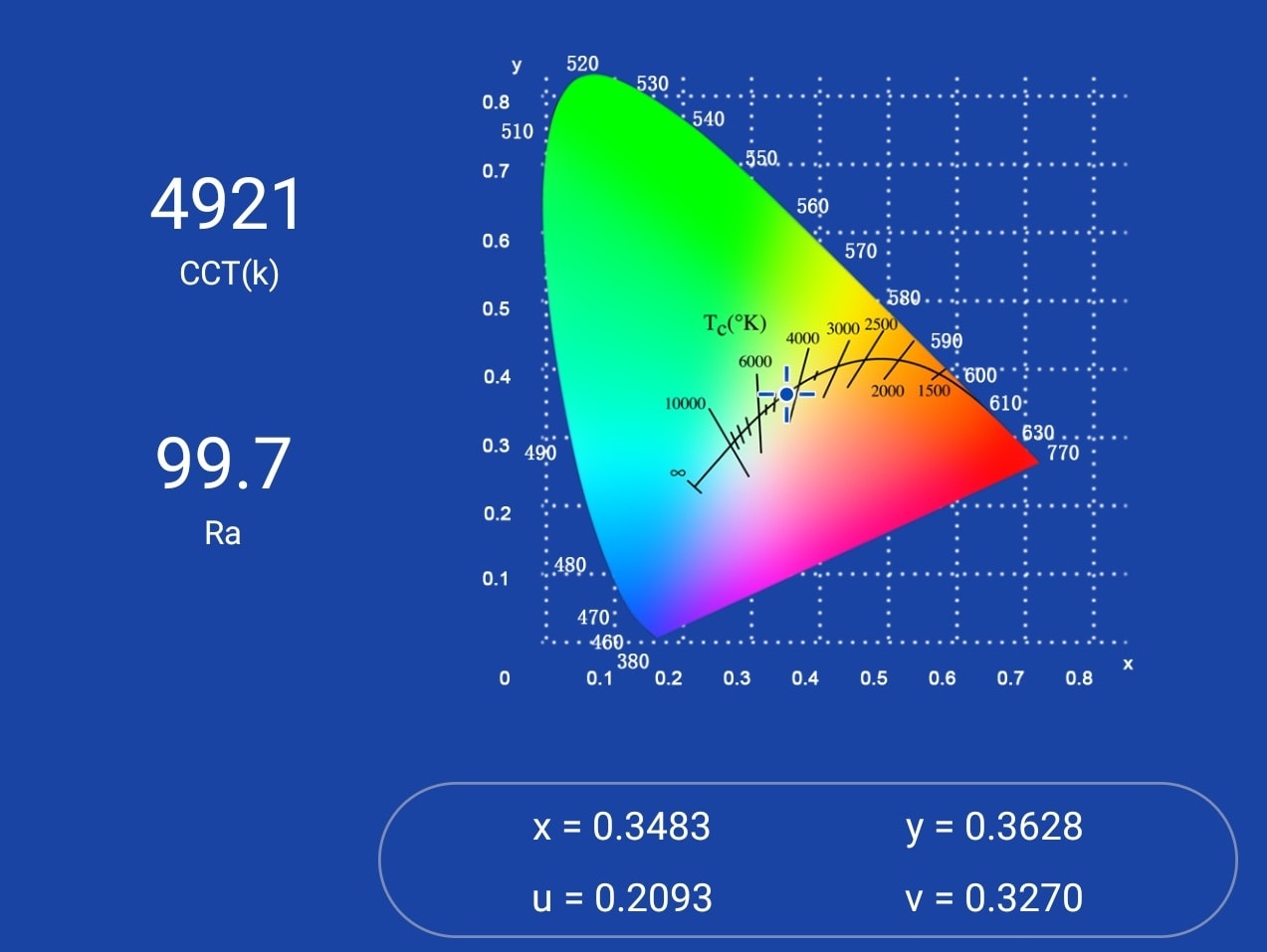
Dimensions and size comparison
Dimensions:
| Acebeam Pokelit 2AA | Millimeters | Inches |
|---|---|---|
| Length | 144 mm | 5.7 “ |
| Head diameter | 18 mm | 0.7 “ |
| Body diameter | 17 mm | 0.7 “ |
Dimensions are rounded to the nearest millimeter, and to the nearest tenth of an Inch.
Weight:
| Acebeam Pokelit 2AA | Weight in grams | Weight in Oz. |
|---|---|---|
| Without battery: | 42 grams | 1.5 oz. |
| With battery | 91 grams | 3.2 oz. |
Weight is rounded to the nearest gram, and to the nearest tenth of an Oz.
Pokelit 2AA flashlight comparison
Size compared to other penlight flashlights
From left to right: Acebeam Pokelit 2AA, Olight i5T Plus, Wuben E19, Acebeam PT10 GT, Olight i3T Plus, Weltool M6-Dr, Wurkkos WK02, Nitecore MT06D, Lumintop IYP365
Only the Acebeam Pokelit 2AA and Olight i5t Plus are 2AA flashlights. All the others us 2AAA batteries.
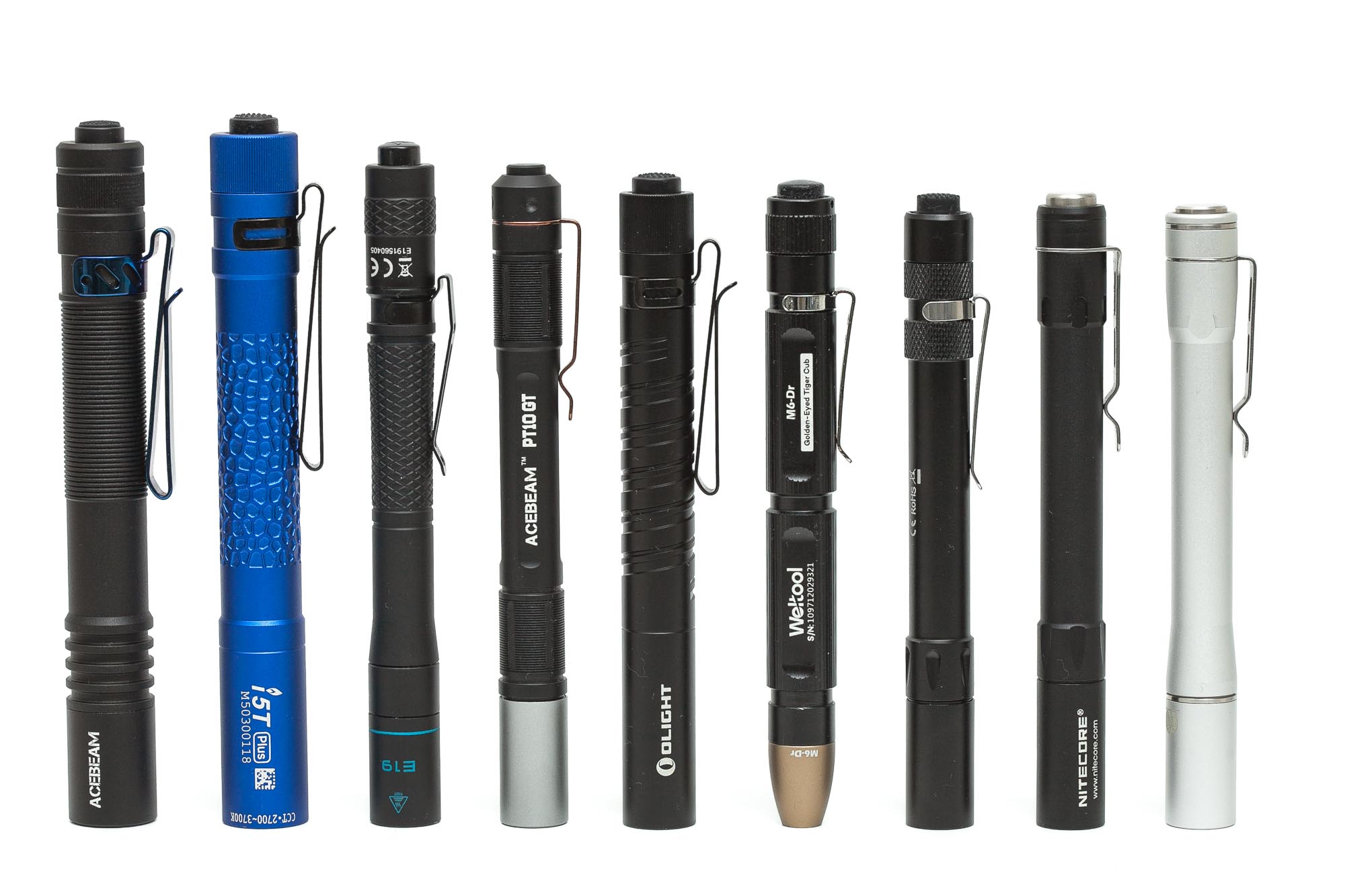
Driver & User Interface:
The Pokelit uses a buck-booster driver because the LED is a 3V LED, but 2AA batteries can go as low as 2V (in series) and the included 14100 battery goes up to 4.2V. So the flashlight works on anything between 2 and 4.2V.
The switch is a forward-clicky switch, so it has a momentary-on feature. It also means you can’t change modes while the switch/light is activated.
The first mode is very dim on AA/NiMH batteries, so I would call it Moon instead of Low.
Available main modes:
- Low, High (with lithium-ion battery)
- Moon, High (with 2AA Alkaline / NiMH batteries)
Available special modes (blinkies):
- N/A
From OFF:
- Half-press: momentary on
- Half-pressing: switching between low and high
- Single-click:turns on selected mode
From ON:
- Half-press: nothing
- Single-click: turns off
Shortcuts:
- None
Mode memory:
- No, it always start in Low mode
Blinky modes menu:
- None
Low battery warning:
- The output reduces, but there is no other warning
Lock-out mode:
- It’s a mechanical switch
PWM:
- Not visible by eye
Firmware / UI Conclusion:
The UI is pretty standard, but the switch is a little different than normal.
Batteries & Charging
One thing I like about this light is the number of batteries you an use.
By default, Acebeam included a 14100 lithium-ion battery, that reads like your average lithium-ion battery, 4.2 volts when fully charged. (Well, mine doesn’t charge to 4.2V though).
Even though it looks like there are 2 14500 batteries installed in series, they are actually connected in parallel. Therefore you only get 4.2V instead of 8.4V you would expect with 2 14500 batteries. And because they connected them in parallel, the total capacity doubled and makes it a 1600mAh battery.
Because it’s such an odd size, you won’t be able to charge it in a normal battery charger. You really have to use a USB-C cable. It works with USB-A to USB-C as well as USB-C to USB-C cables.
The charge current is roughly 0.5A with either type of cable used. So you don’t get any additional benefits of using a PD charger for example. And during charging, you see a red indicator light, which turns green when it finishes.
I measured the total charging time at 3 hours and 45 minutes.
Instead of the 14100 battery, you can also use 2AA batteries. Alkaline, as well as NiMH batteries, work, but I don’t recommend using primaries, simply because they are prone to leak.
Note: you are not allowed to replace the 14100 battery with 2 pieces of 14500 batteries, because that would make the total voltage 8.4V and ruin the flashlight. Plus, you will lose warranty doing so.
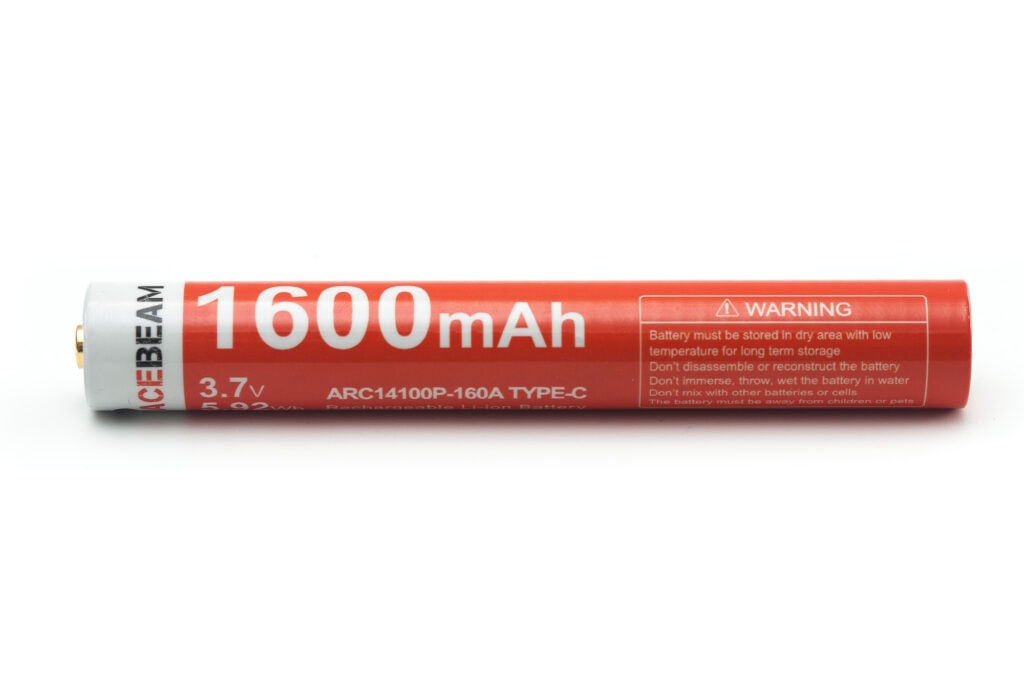

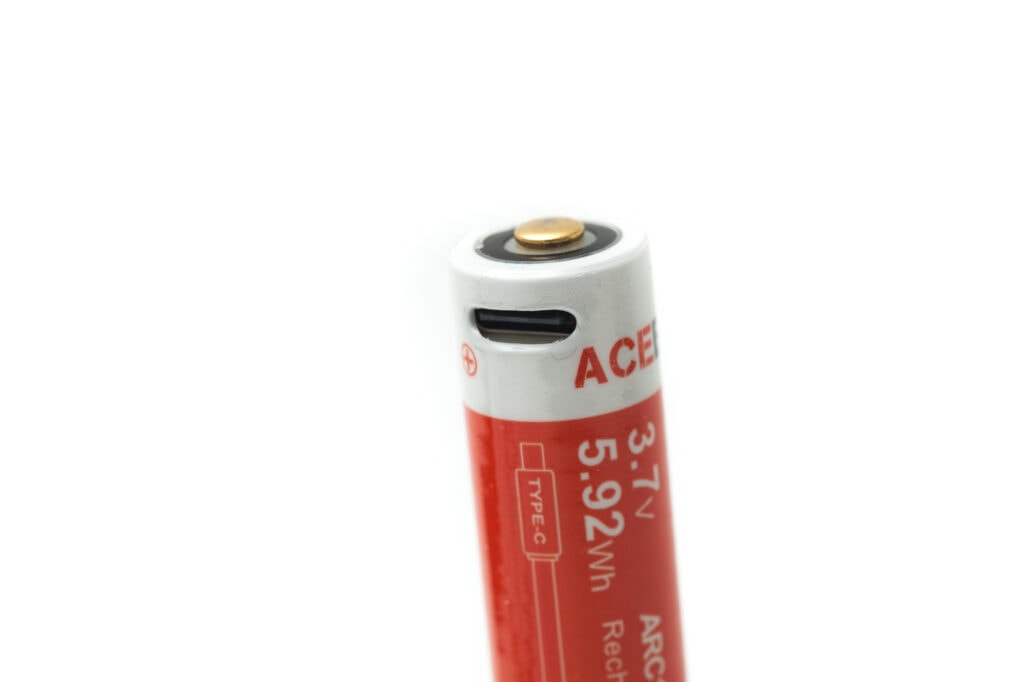
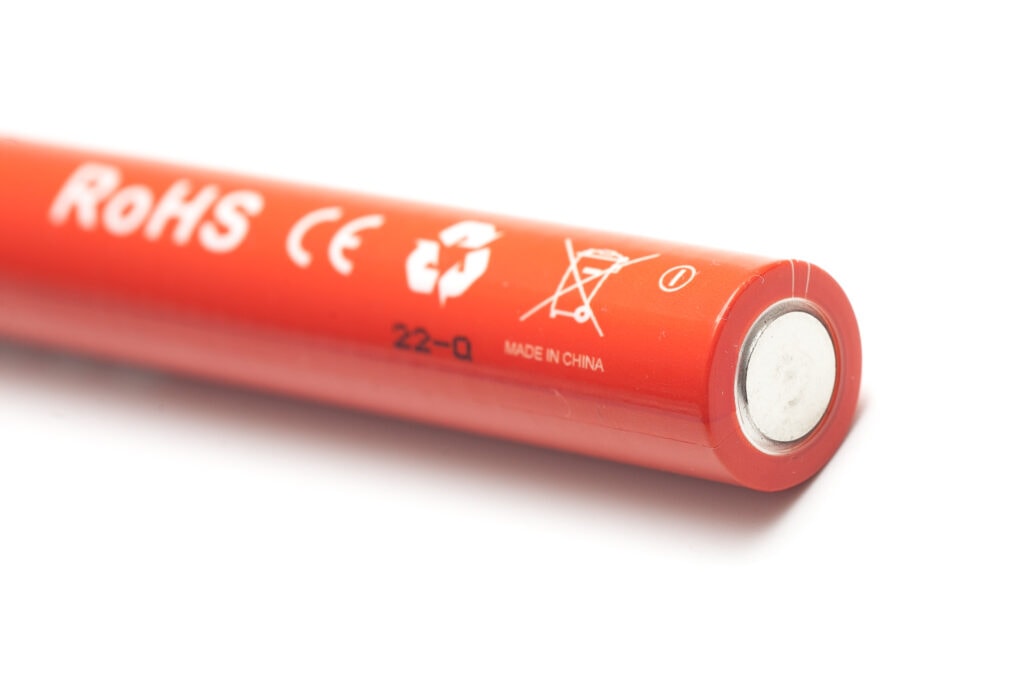
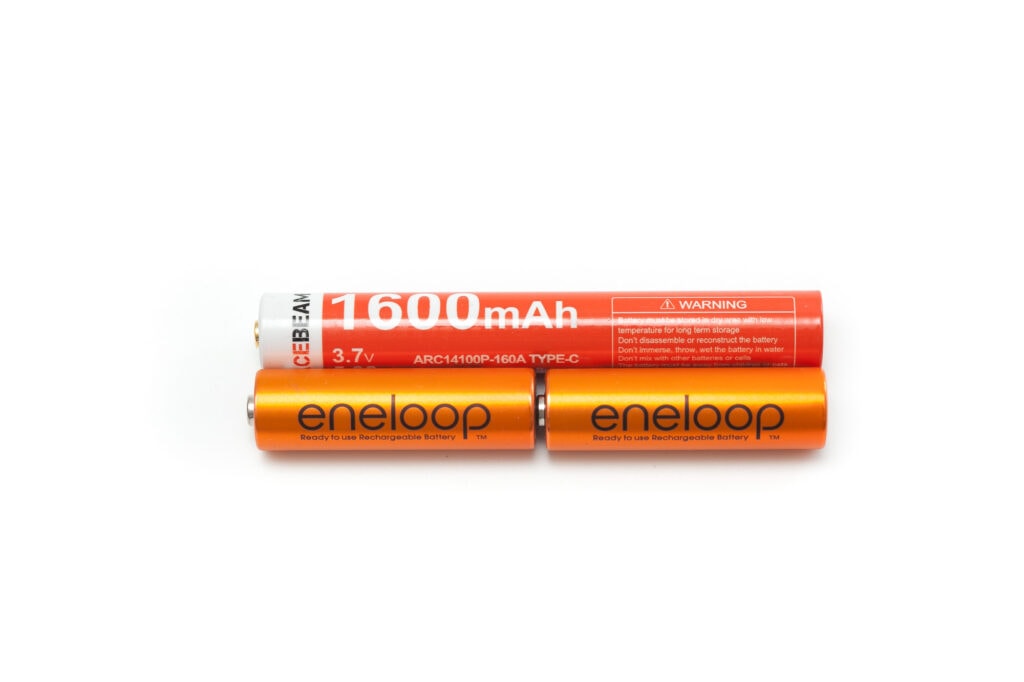
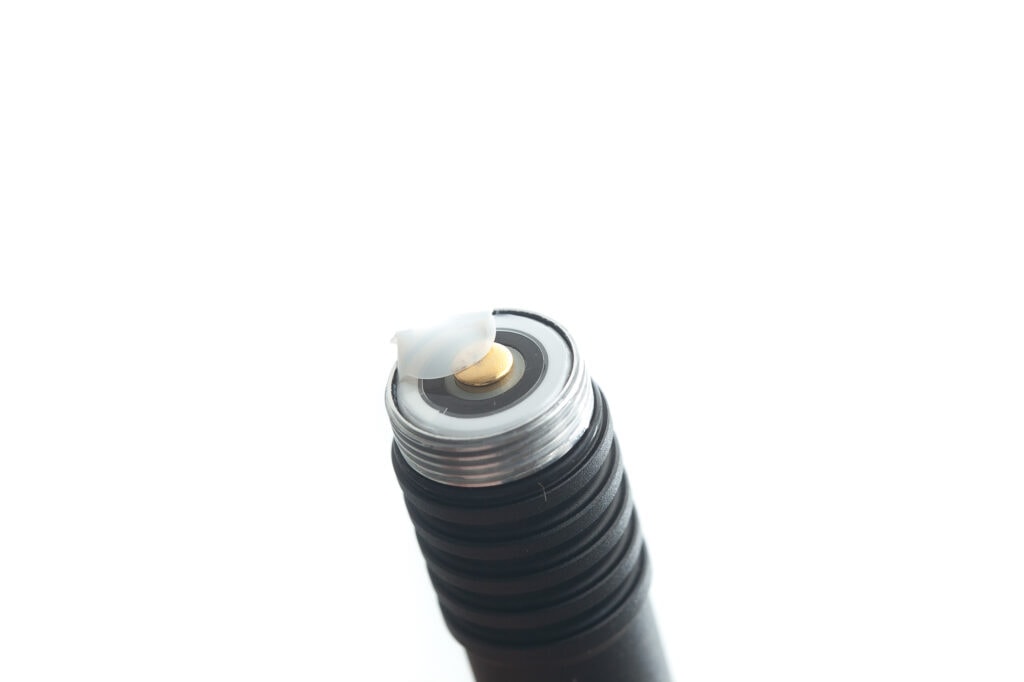
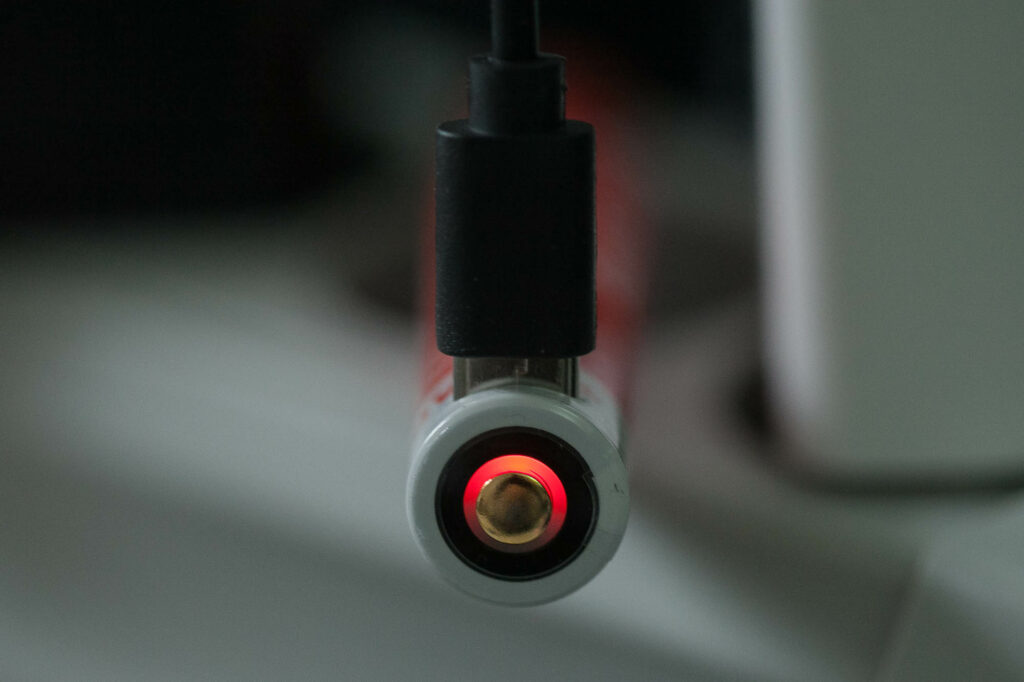
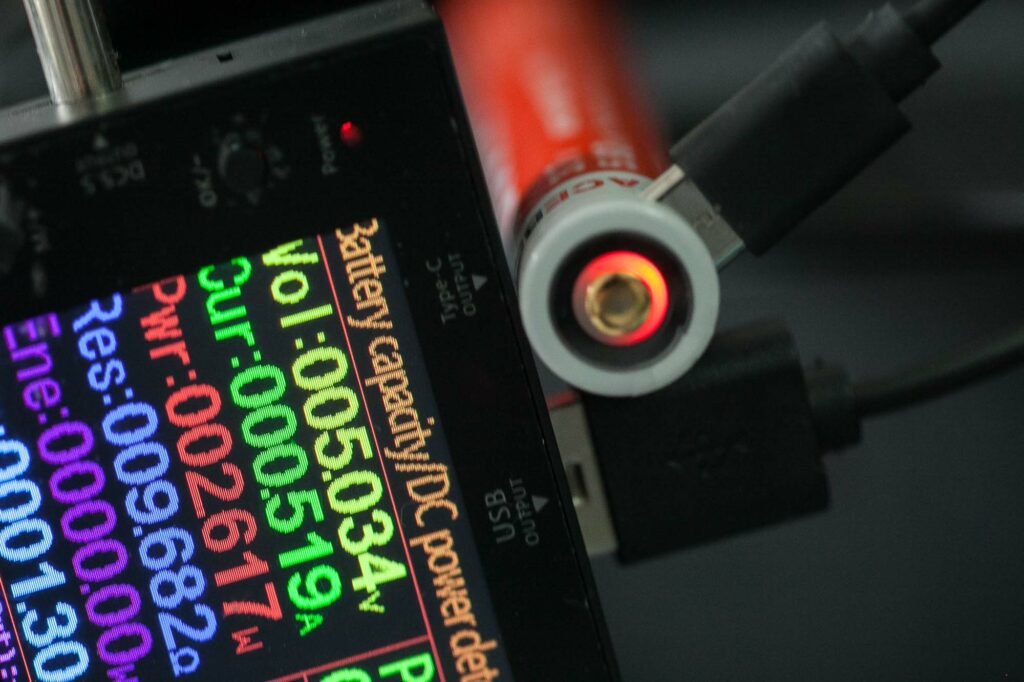
Performance test
Lumen measurements:
The output measurements in this review are based on my homemade integrating spheres, each equipped with an Extech SDL400 Lux Meter. For consistency and accuracy, a calibration light (Convoy S2+ with 249lm and a Convoy S2+ with 261lm) is measured prior to each set of lumen measurements.
For high-output lights, one of the lux meters uses an ND camera filter to prevent the lux meter to max out. This is either the Kenko PRO1D ND16 up till about 80,000 lumens or Gobe ND32 for anything above.
All of my readings were taken from a fully-charged 14100 battery, and 2 Eneloop AA batteries.
The measurements were taken manually at turn on and 30 seconds. The 10-minute numbers are taken from the runtime graph.
With 14100 lithium-ion battery:
| Mode | Specs | At turn on | 30 seconds | 10 minutes |
|---|---|---|---|---|
| Low | 20 | 16 | 17 | 16 |
| High | 600 lm | 570 | 543 lm | 303 lm |
I also manually measured the output at 60 seconds (463 lm), 90 seconds (329 lm) and 2 minutes (319 lm). The light increases brightness directly after activating, so the 0sec measurement is lower than the 30sec measurement in some cases.
Here are the measurements with 2 Panasonic Eneloop AA batteries:
| Mode | Specs | Turn on | 30 seconds | 10 minutes |
|---|---|---|---|---|
| Low | 0.5lm | 0.3 | 0.4 | – |
| High | 300lm | 239 | 240lm | 70 lm |
I used rounded numbers for the output in High mode.
Parasitic drain:
- Nothing to measure
Acebeam Pokelit 2AA battery life and runtime graphs
The runtime tests were done in the 50cm home made integrating sphere, combined with the Extech SDL400 data logging Lux Meter.


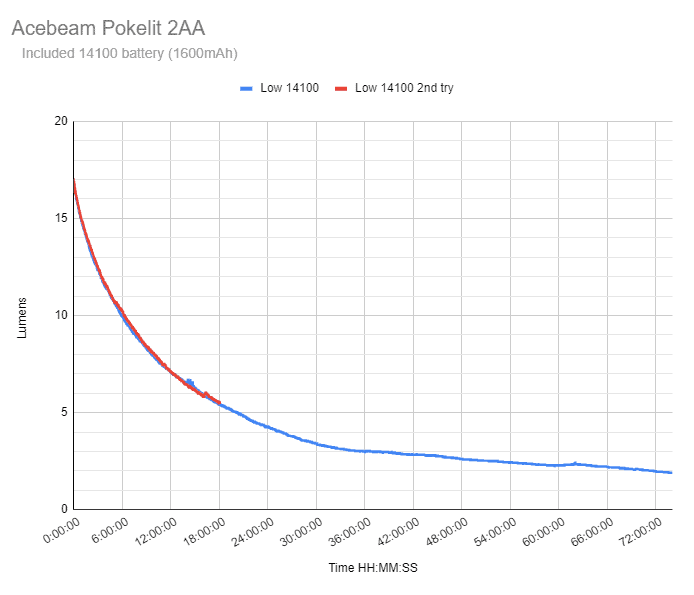
| Mode | Specified | Measured runtime (ANSI FL1) | Time till shut off |
|---|---|---|---|
| 14100 lithium: Low | 23h | 74h+ | 74h+ |
| 14100 lithium: High | 1h 44min | 1h 58min | 1h 58min |
| Eneloop AA: High | 5h 23min | 5h 54min | 6h 18min |
I tested Low mode, with 14100 battery 2 times.. and the second time I stopped the runtime prematurely, after 18 hours. I wanted to see if my first runtime was a glitch or something. The runtimes were identical till the point I stopped the test. At that point, the output was down to 5 lumens, and voltage still at 3.78 volts.
After 74 hours I stopped the original low-mode test, but it could have run much longer. Why? Because the end Voltage was still 3.5V. I don’t understand why it didn’t sustain a higher output? After 74 hours it was down to 1.9 lumens, at 3.5V. That doesn’t make much sense. And the ANSI runtime cutoff would have been 1.7 lumens (10% of the initial measurement), which would have been a couple more hours. But at 3.5V, you shouldn’t really want to measure less than 2 lumens, when the initial output was only just 17 lumens.. It could have stayed 17 lumens throughout the whole runtime.
After the Eneloop test, I measured 0.86 v for 1 battery, and the other one didn’t measure anything. That’s no good. This happens a lot with these multi-AA battery flashlights.
I don’t want to do the Low runtime test, which starts at only 0.4 lumens, and runs for 13 days straight (according to specs).. which is kind of useless in most cases, and could eventually end in dead Eneloop batteries as well.
ANSI FL1 standards: The runtime is measured until the light drops to 10% of its initial output (30 seconds after turning it on). This does not mean that the flashlight is not usable anymore. The last column shows how long the light actually works till it shuts off. If there is a + symbol, it means that the test was stopped at that particular point, but the light was actually still running. This happens on certain occasions, with certain drivers, firmware, or batteries.
Acebeam Pokelit 2AA peak beam intensity- and beam distance measurements
Measurements were taken indoors at 3 meters with a Hagner E4-X Lux Meter.
| Mode | Specs | Candela measured | Meters | Yards |
|---|---|---|---|---|
| Eneloop High | – cd | 846 cd | 58 | 64 |
| 14100 Low | – cd | 63 cd | 16 | 17 |
| 14100 High | 2550 cd | 1881 cd | 87 | 95 |
Unfortunately, it didn’t reach the specced beam intensity, but in this case, with this kind of light, that doesn’t matter too much in my opinion.
Low mode with the Panasonic Eneloops was too weak at 3 meters. Even at 1 meter, it was reading only 1-2 lux..
Extra info: Peak beam distance according to ANSI FL1 standards: The calculated value of distance in meters at which the flashlight produces a light intensity of 0.25 lux. (0.25 lux is about the brightness of a full moon shining on an object).
Beamshots
For the following beamshots, I used a Canon EOS 5D Mk2 with a 50mm lens. Manual settings: ISO1600, 1/40sec, F4, 5000K
The wall is about 5-6 meters, and the fence is about 4 meters away.
The following flashlights are compared:
- Acebeam Pokelit 2AA
- Olight i5T Plus (in WW, CW, and NW)
- Olight i3T Plus
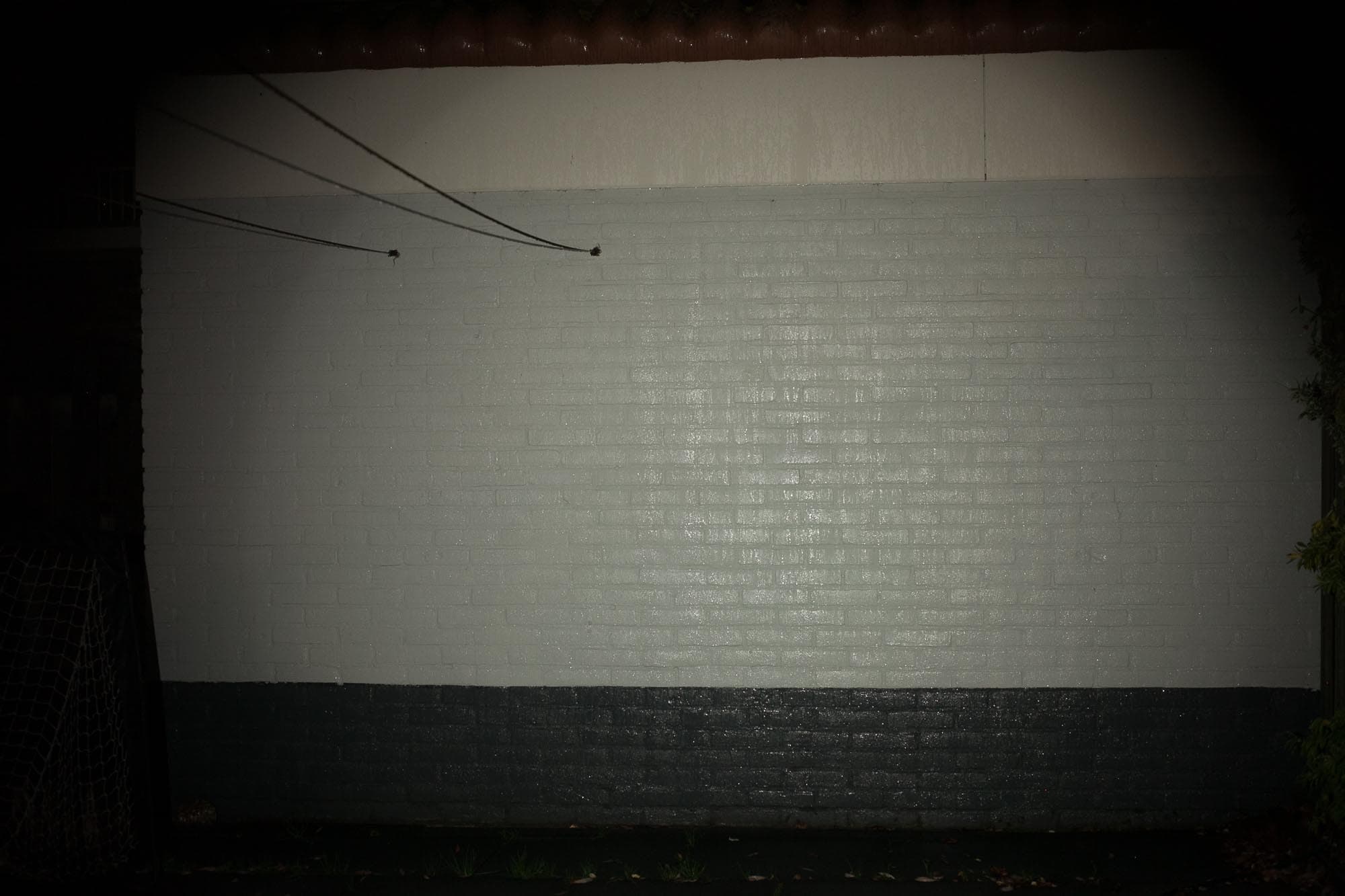
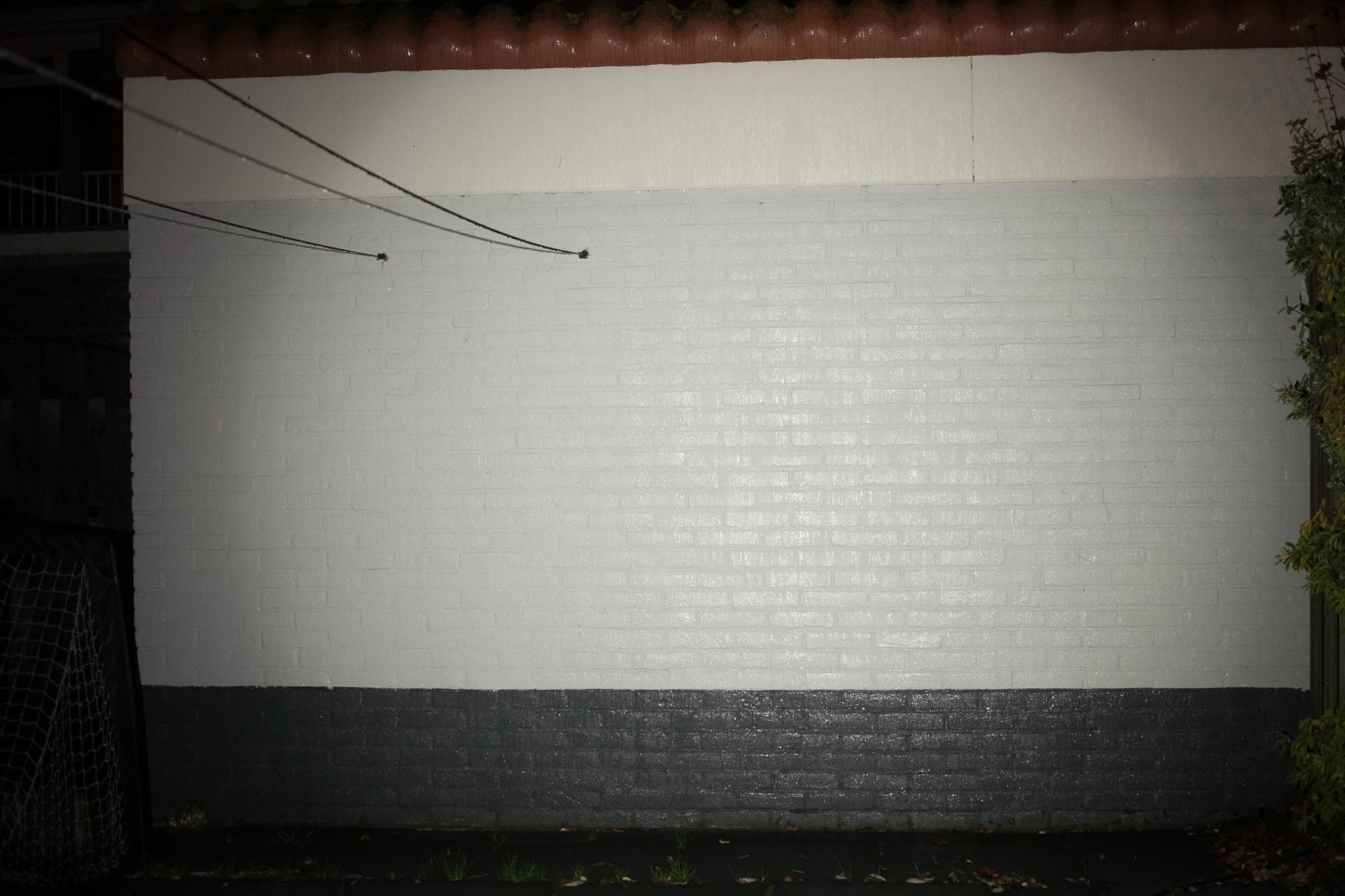

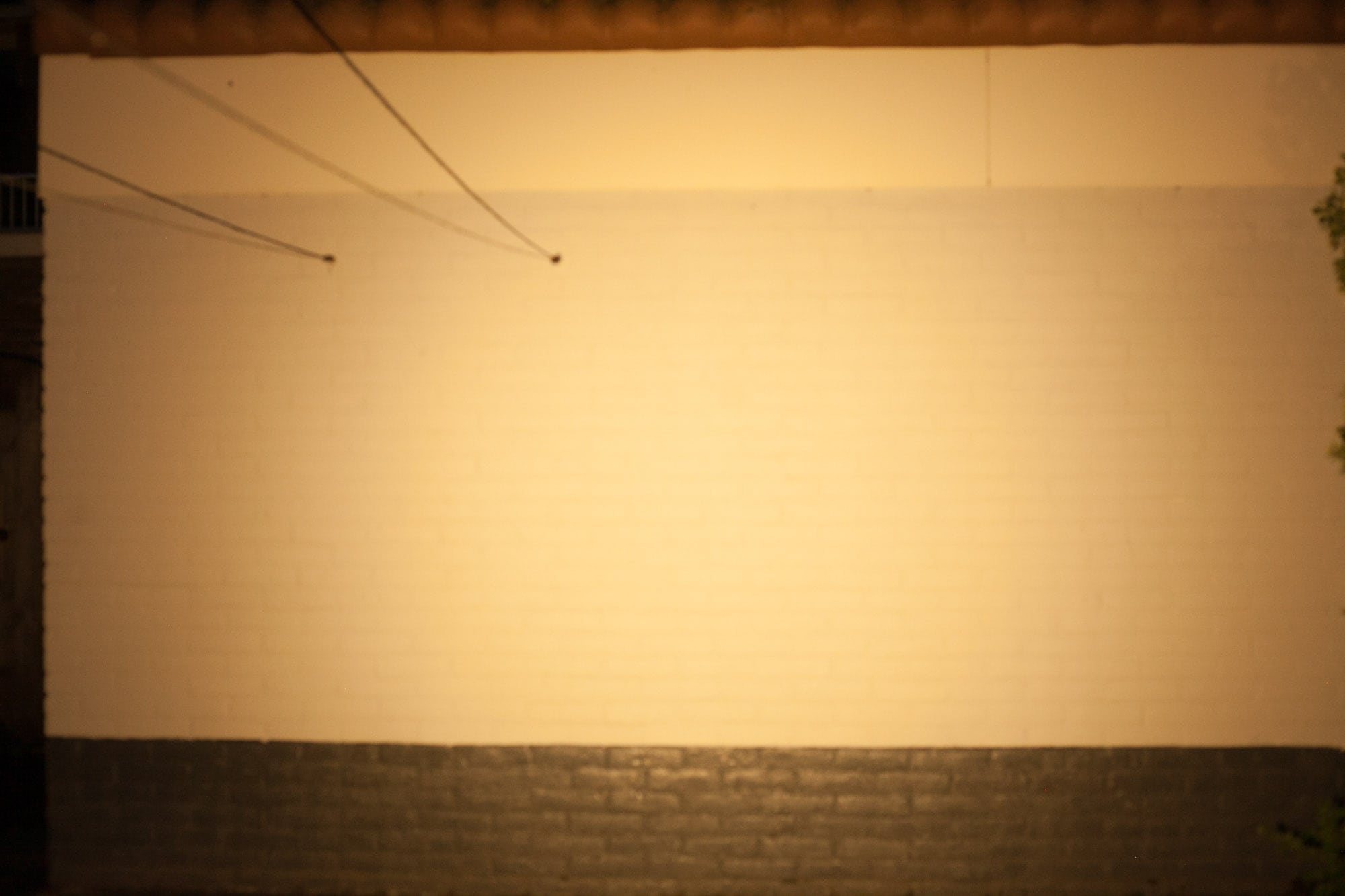
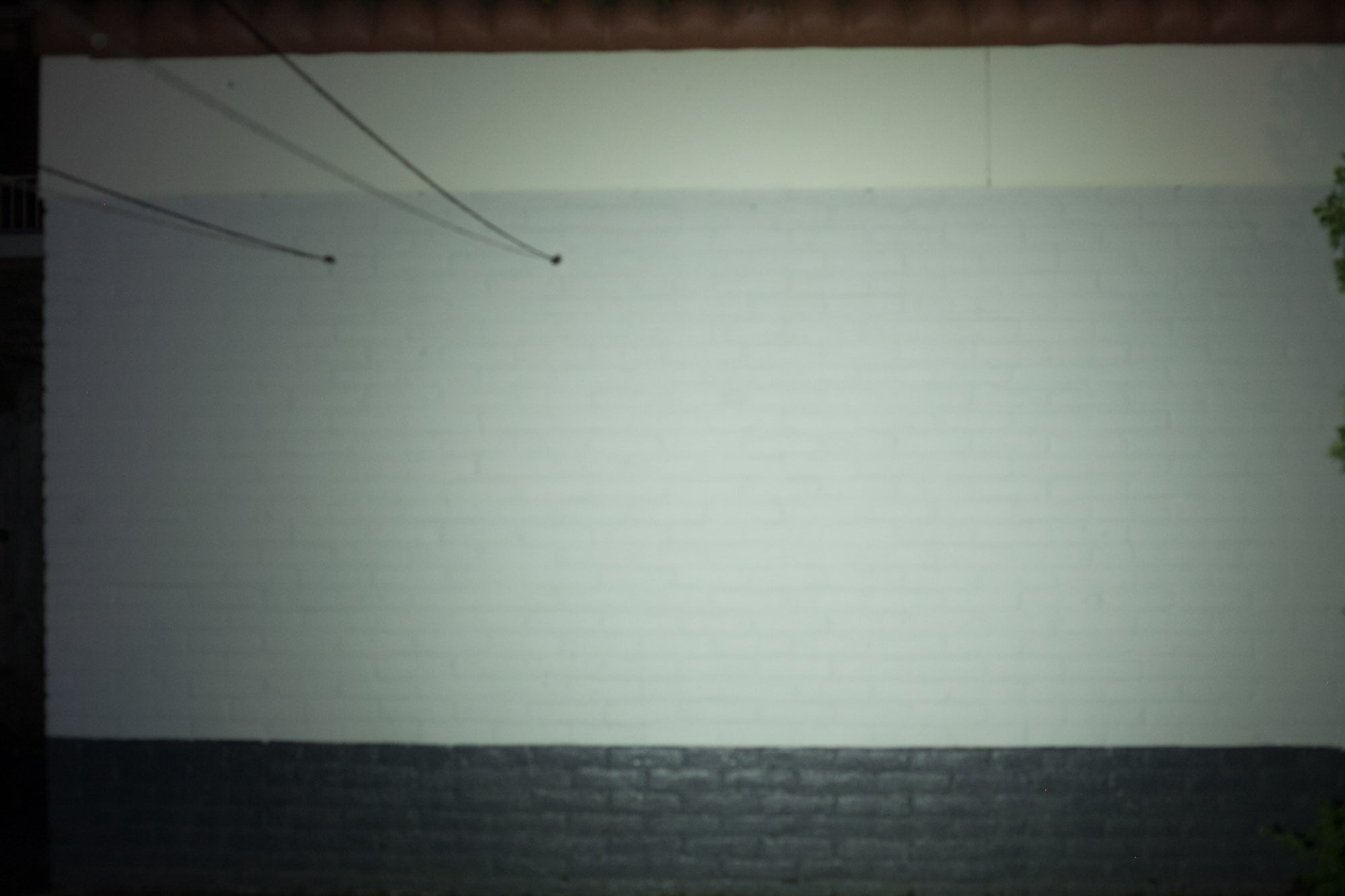
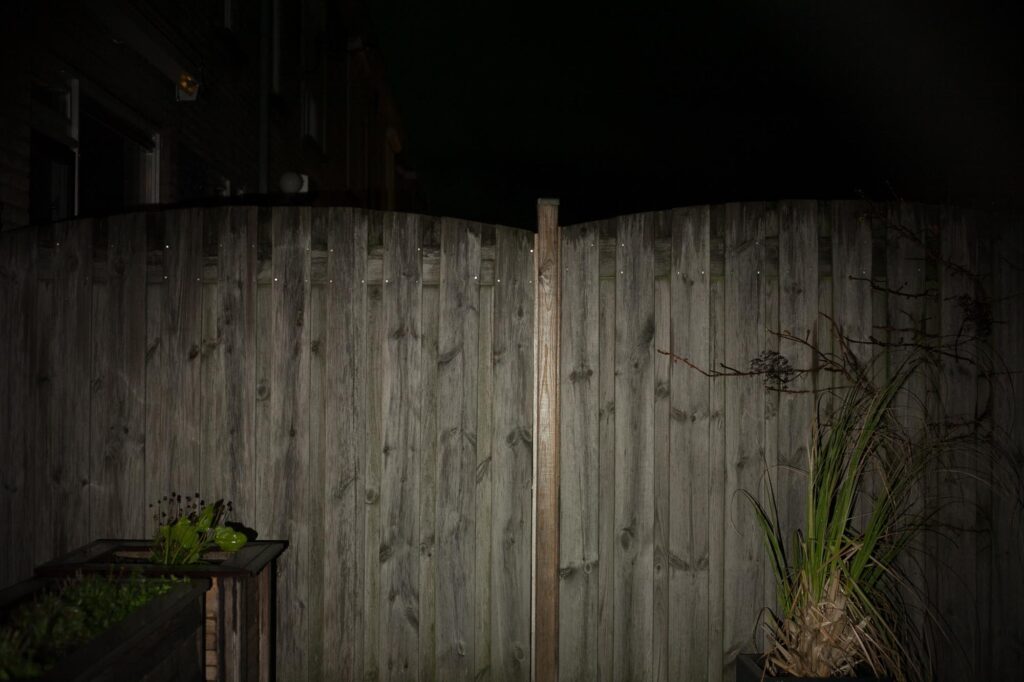
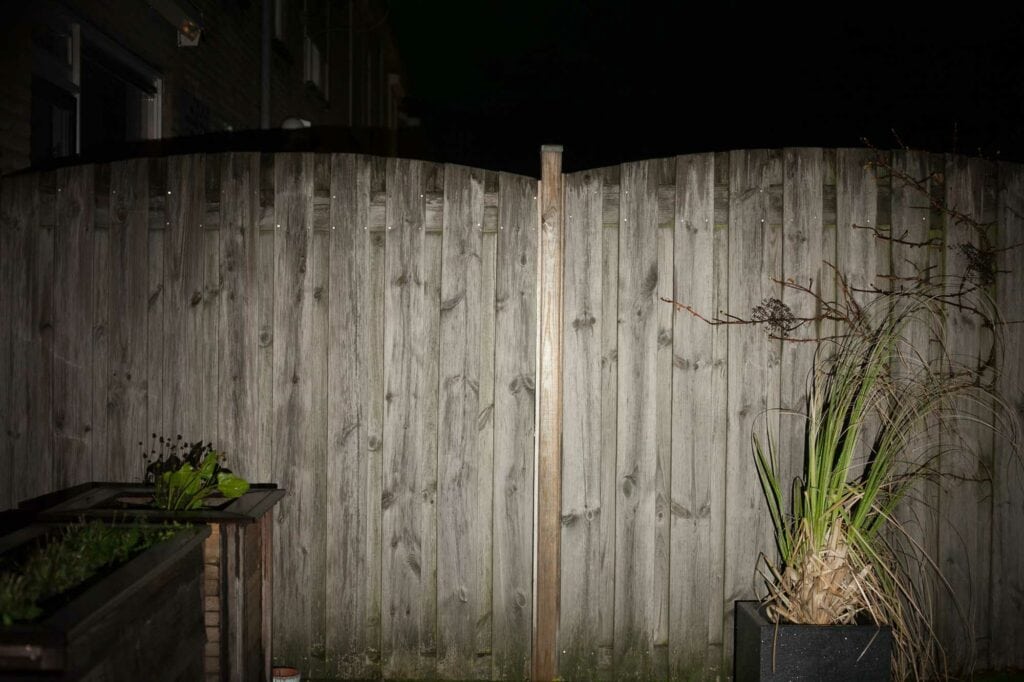
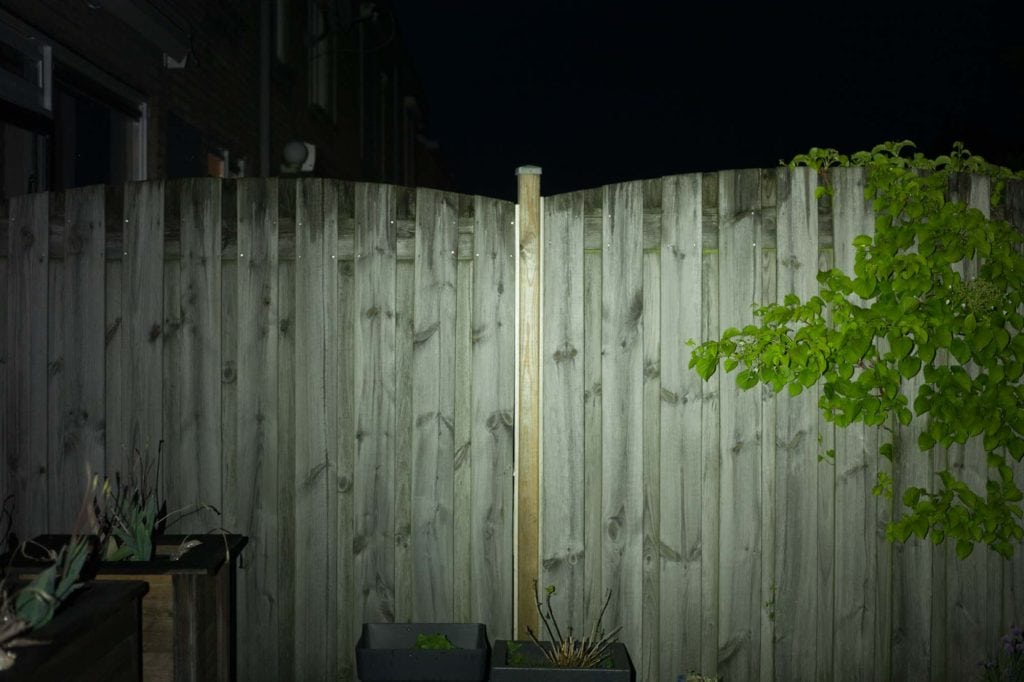
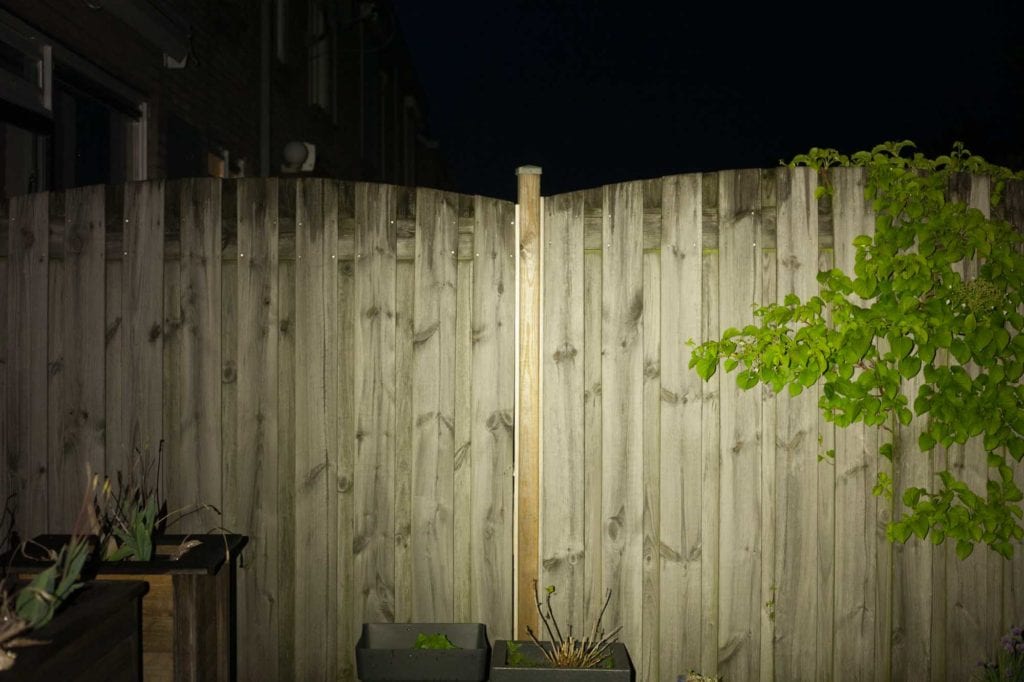
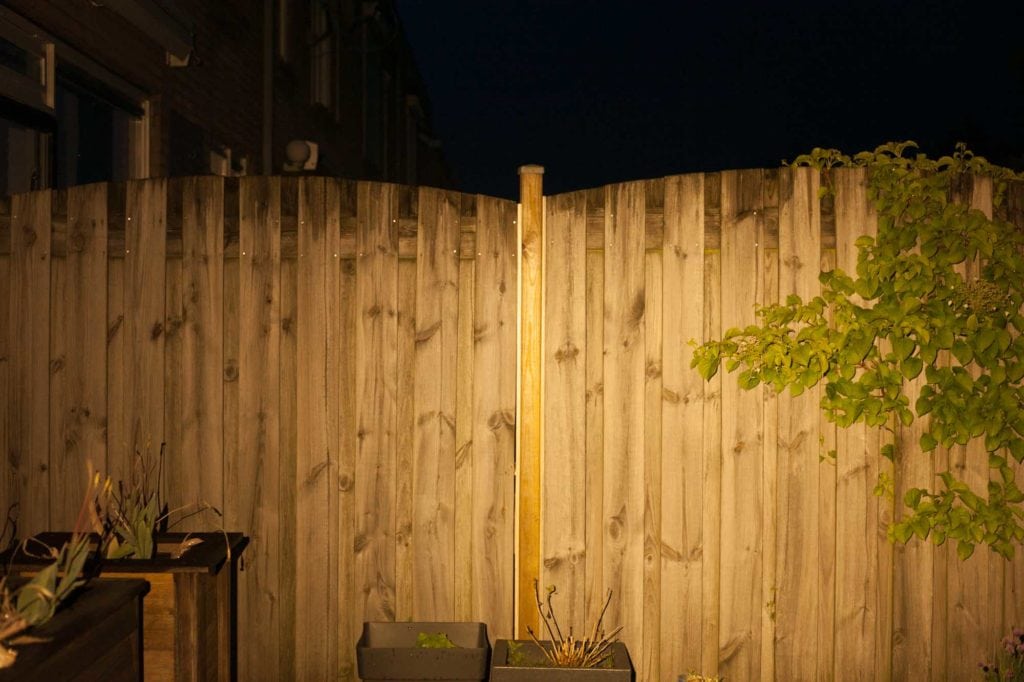
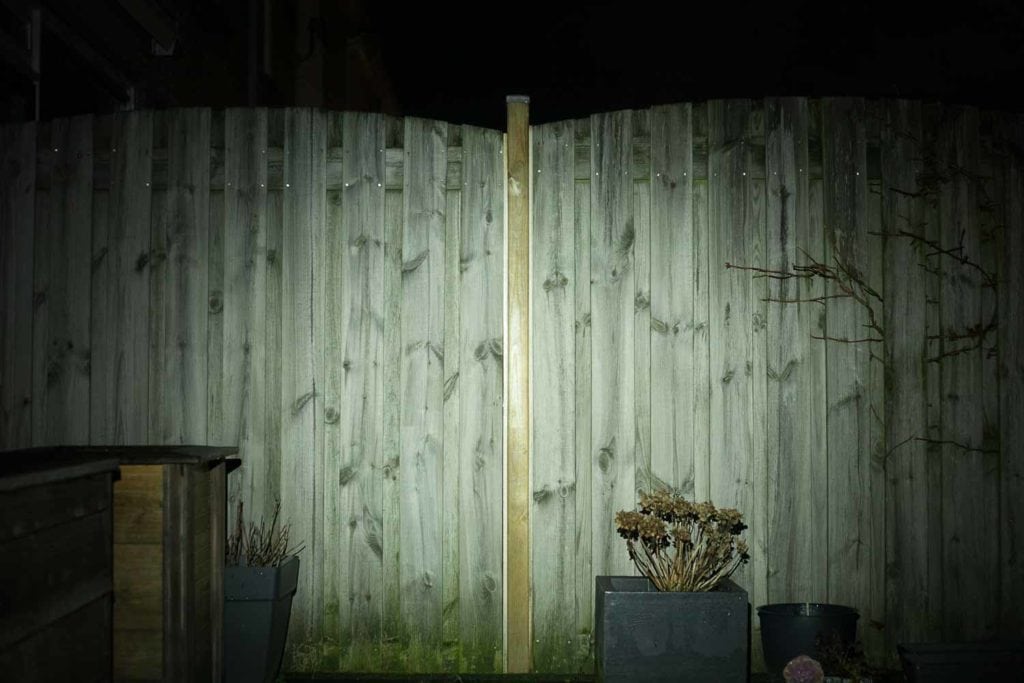
Disclaimer: This flashlight was sent to me for review at no cost by Acebeam. I have not been paid to review, nor have I been holding back on problems or defects.
Final Verdict
Pros
- Includes lithium-ion battery with USB-C port
- Plenty bright for this type of light, with lithium-ion battery
- Very nice, large, and evenly lit hotspot
- Works with 2AA batteries (disposables and rechargeables)
- Extremely long runtime in low (but very weak)
- No visible PWM
Cons
- Gap between Low and High is too big on NiMH batteries. And also very big on lithium-ion, but less problematic
- Low mode is too low on AA primaries and rechargeable AAs for everyday use.
- Can hurt NiMH batteris when you completely drain them. No useful Low Voltage protection.
Explanation on star ratings:
1: Avoid: my phone flashlight would be a better choice – 2: Poor: significant defect or issues; almost unusable – 3: Average: some defects or issues; but still usable 4: Good: recommended (minor issues) – 5: Great: highly recommended

With 14100 battery: 4 stars: ★★★★
With AA batteries: 3 stars: ★★★
If you’re purely looking for a 2AA flashlight, and primarily use AA batteries, this may not be your best bet. However, if you just want to use it with the included 14100 battery (and I encourage you) and only in High mode, it’s a pretty decent flashlight. I quite like the beam and output in High. I still can’t give it 5 stars with the 14100 battery because of the large gap between Low and High, as well as its runtime performance in Low. I would have preferred a stable current controlled driver, where you get X hours at so many lumens. Right now, it runs forever at an unstable output, and after 74 hours it was still measuring 3.5Volts.
Buy Acebeam Pokelit 2AA with a discount
Get a whopping 15% off your next order at Acebeam.com with the following discount coupon: AE15. Simply add the coupon code at your checkout.
1lumen selects and reviews products personally. We may earn affiliate commissions through our links, which help support our testing.